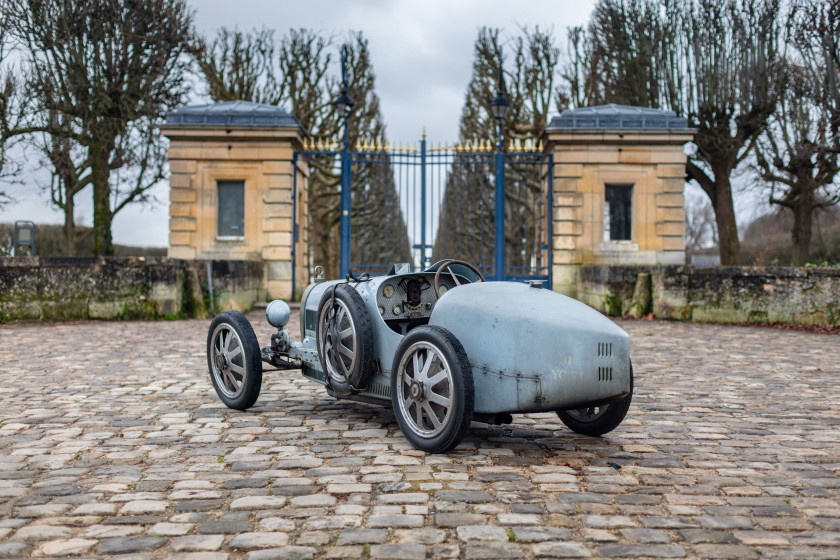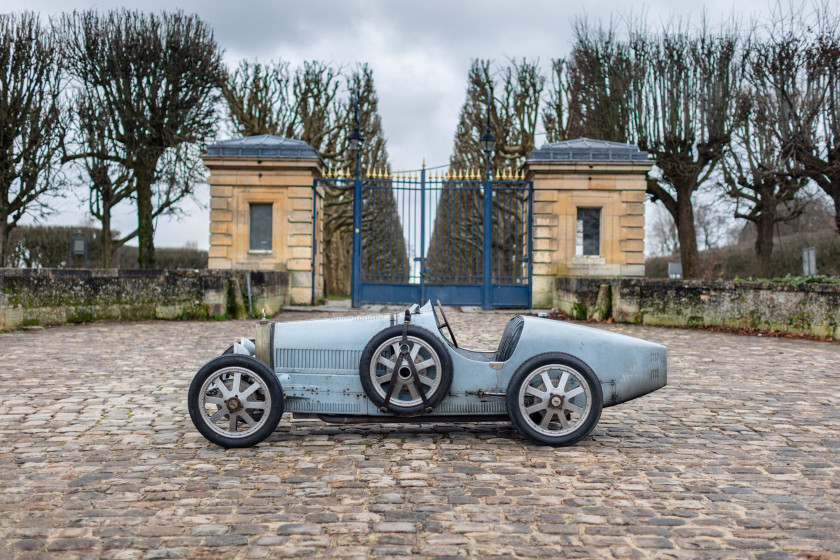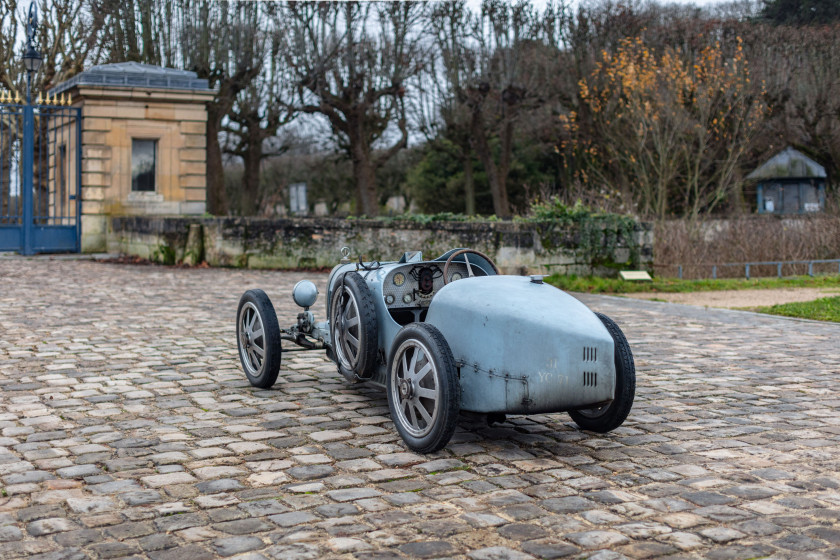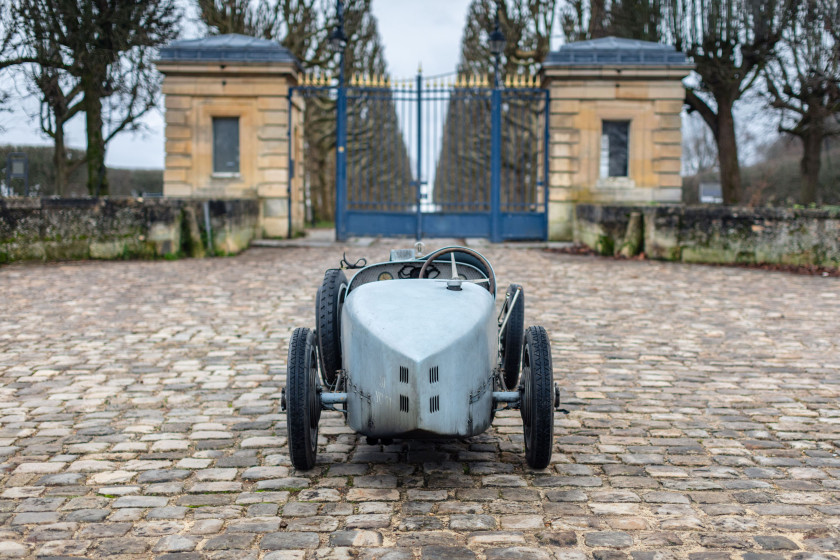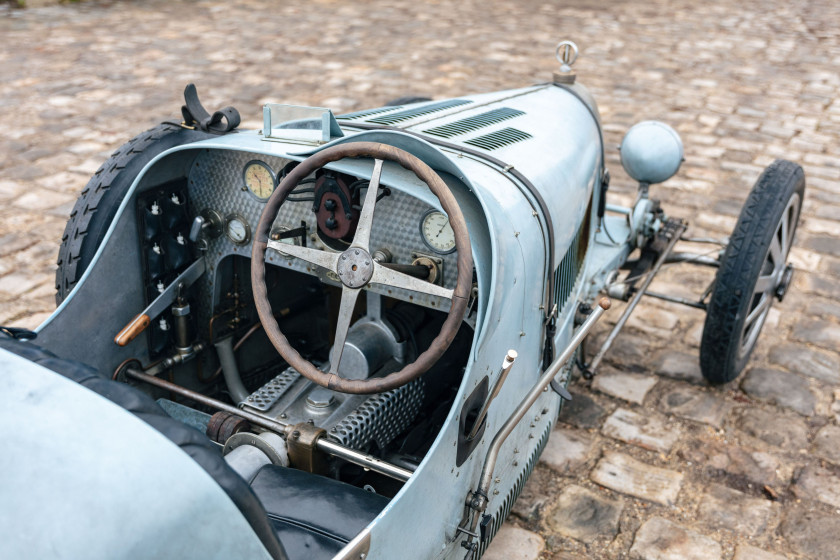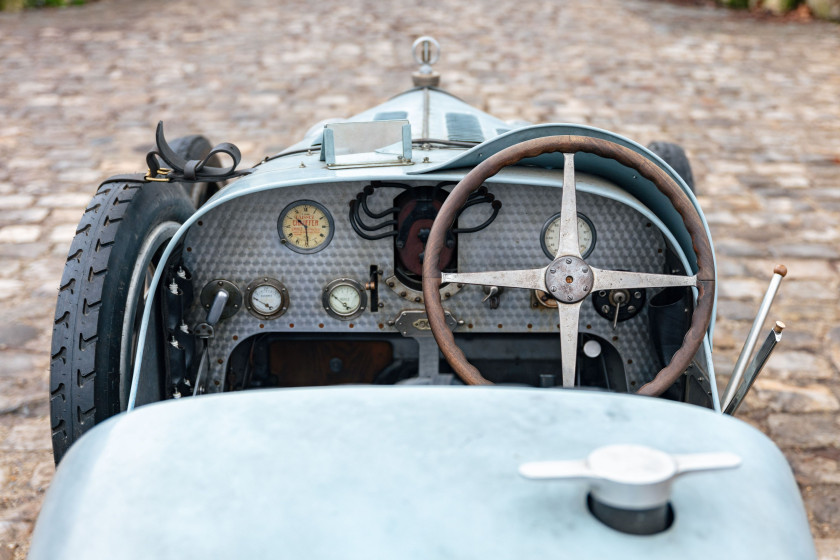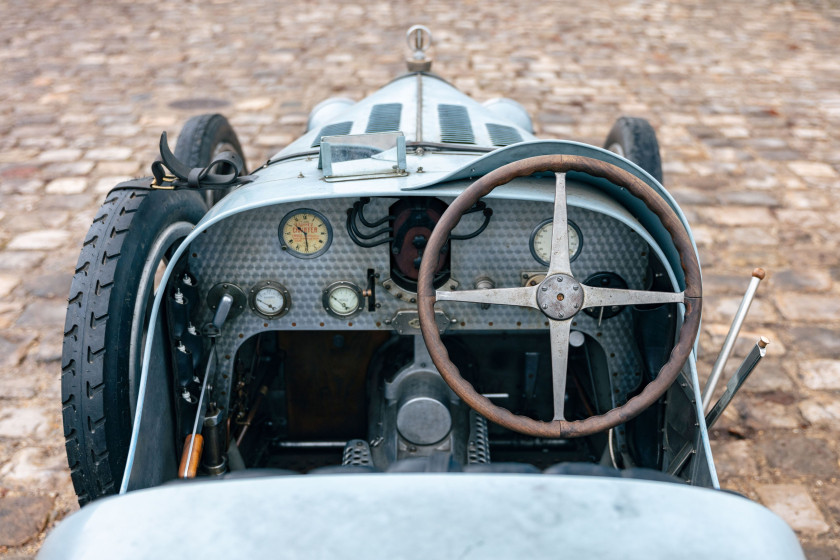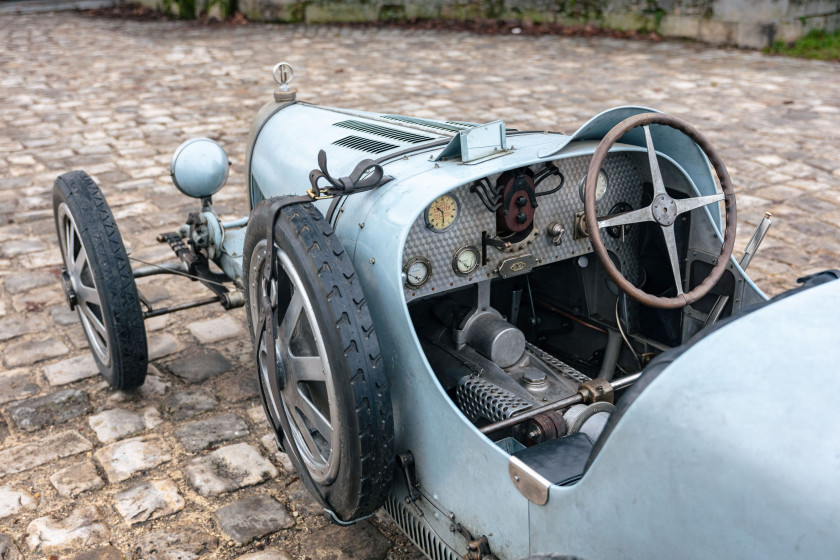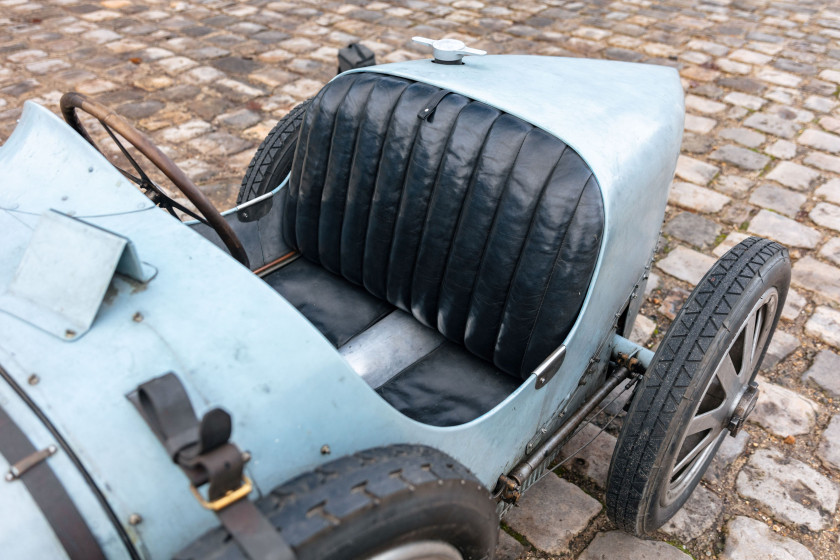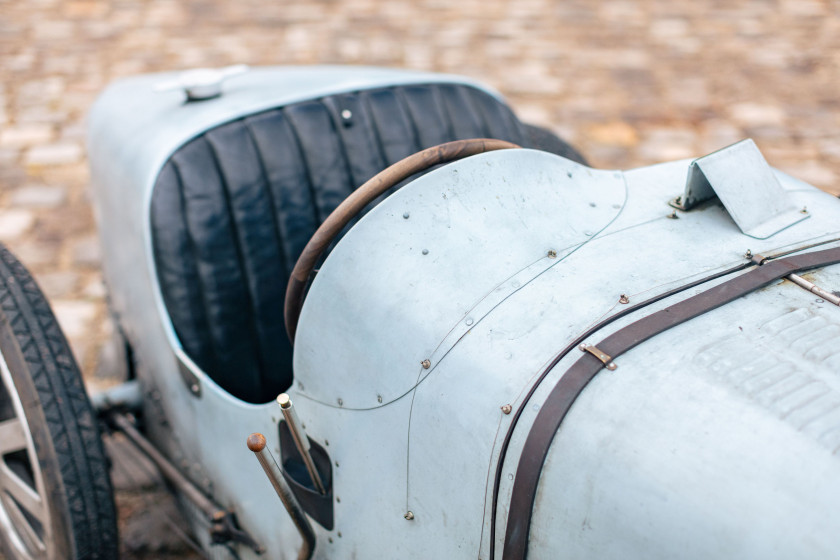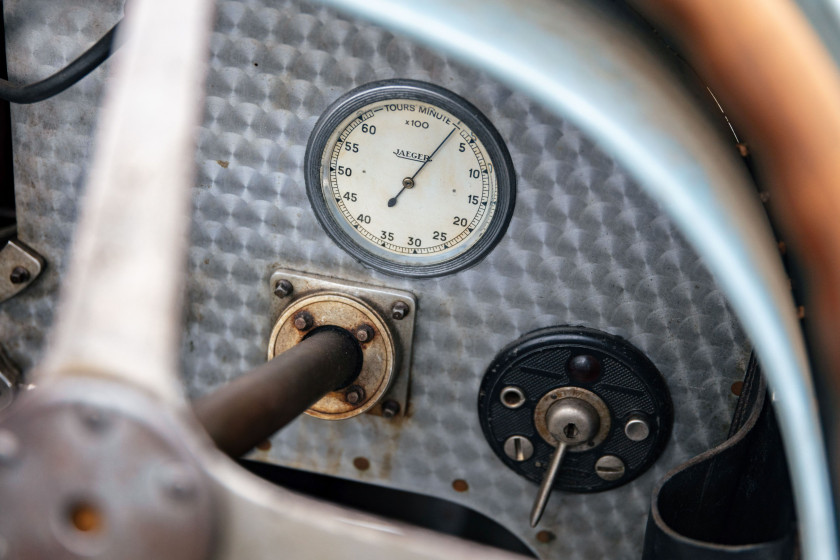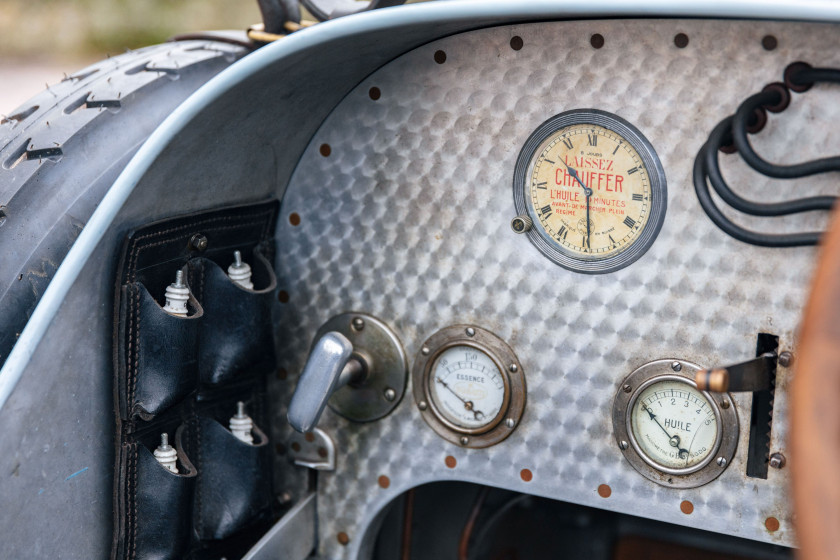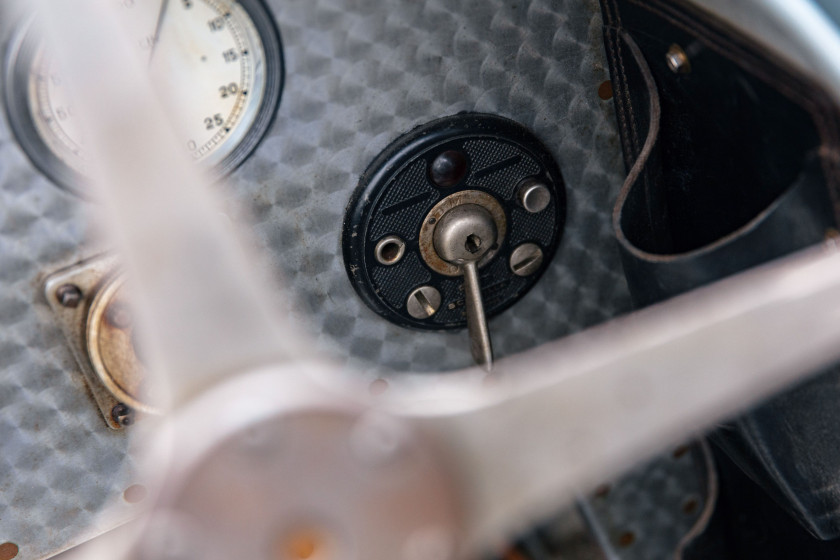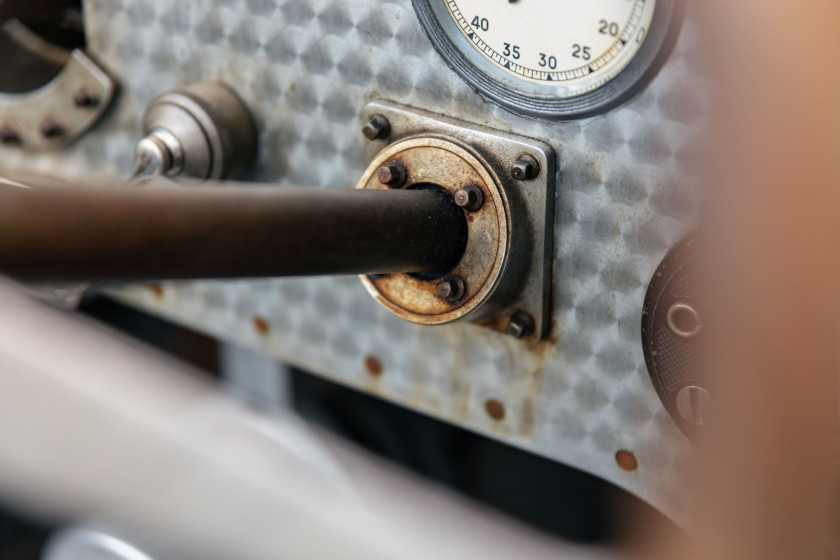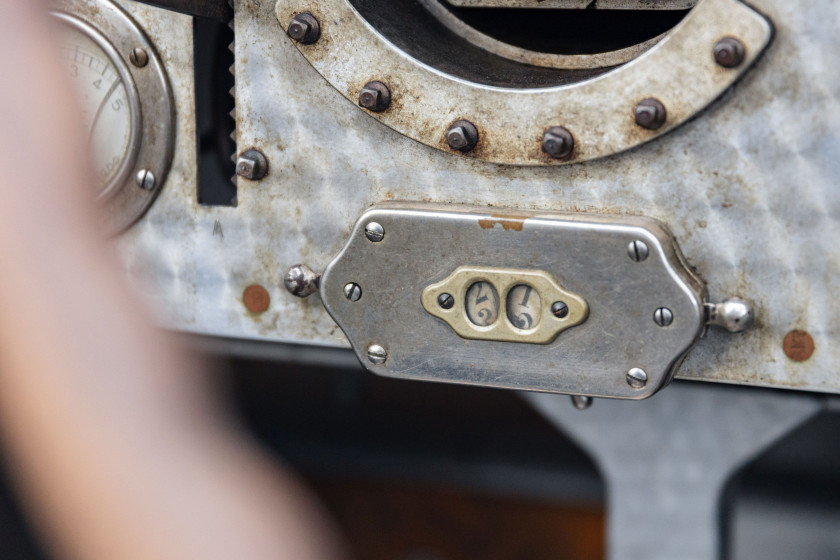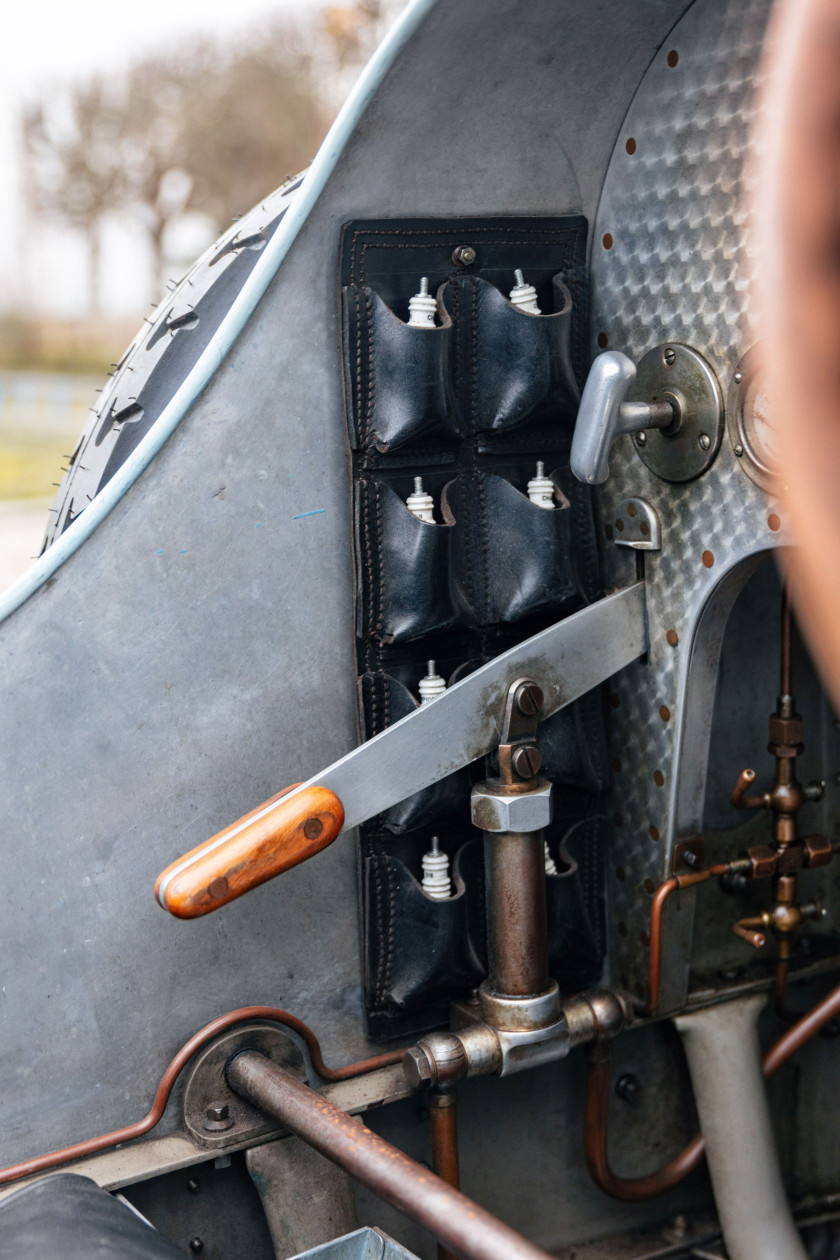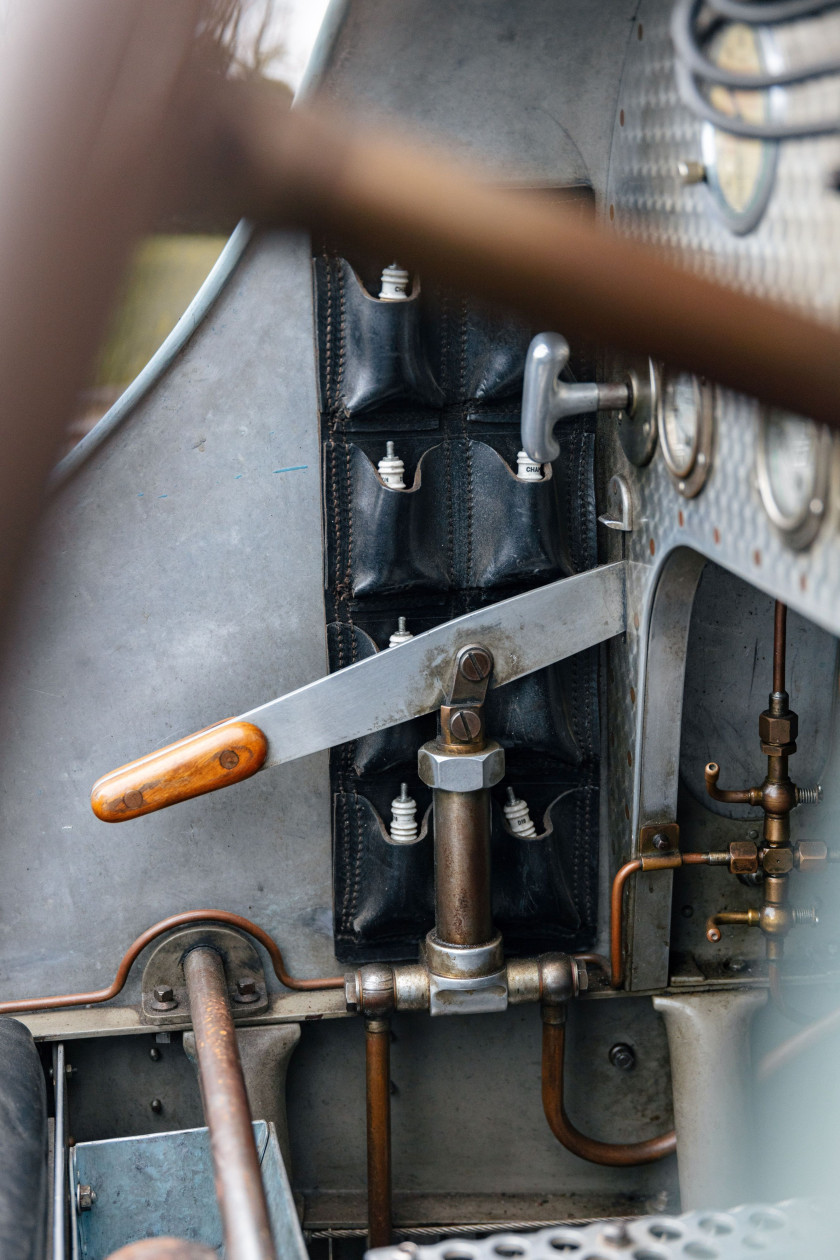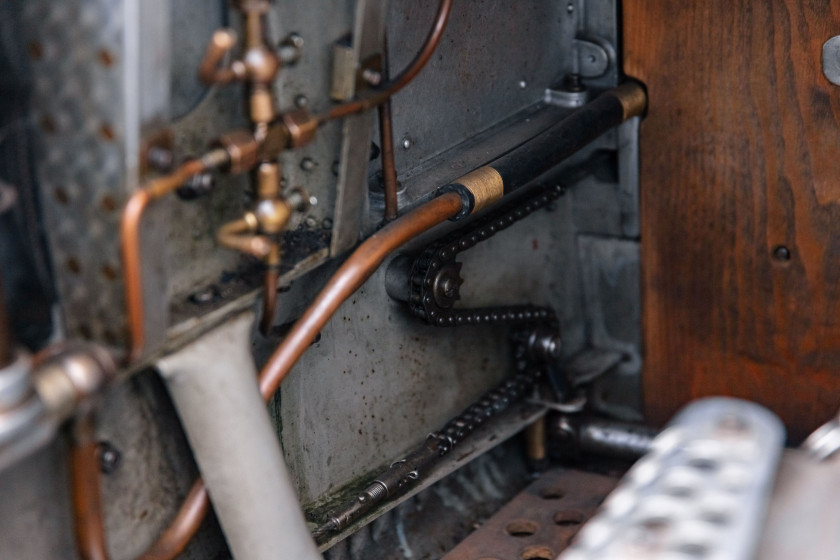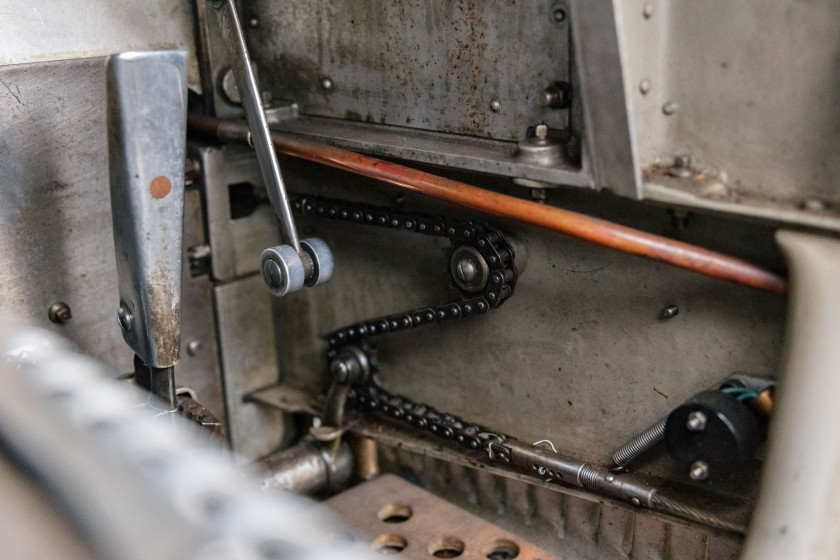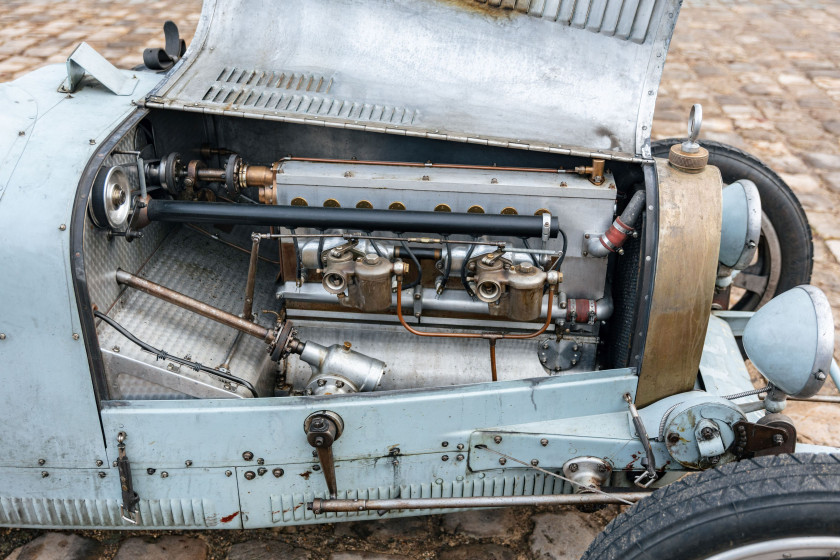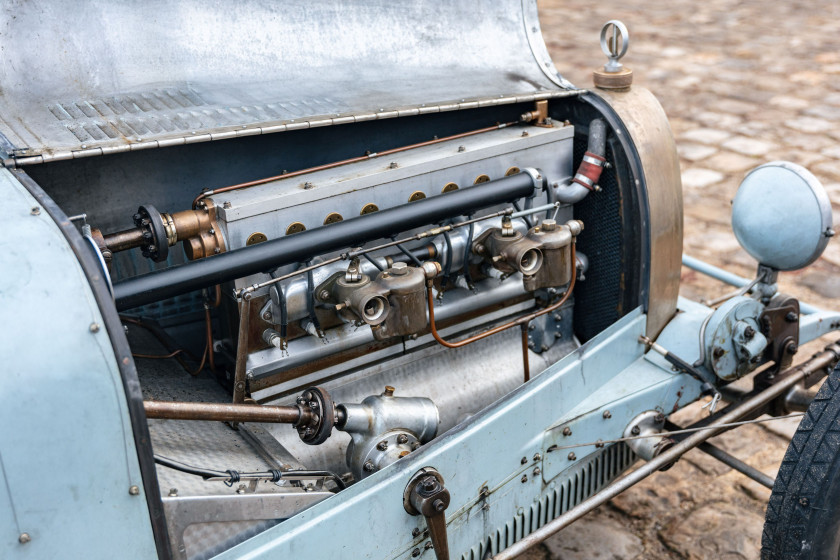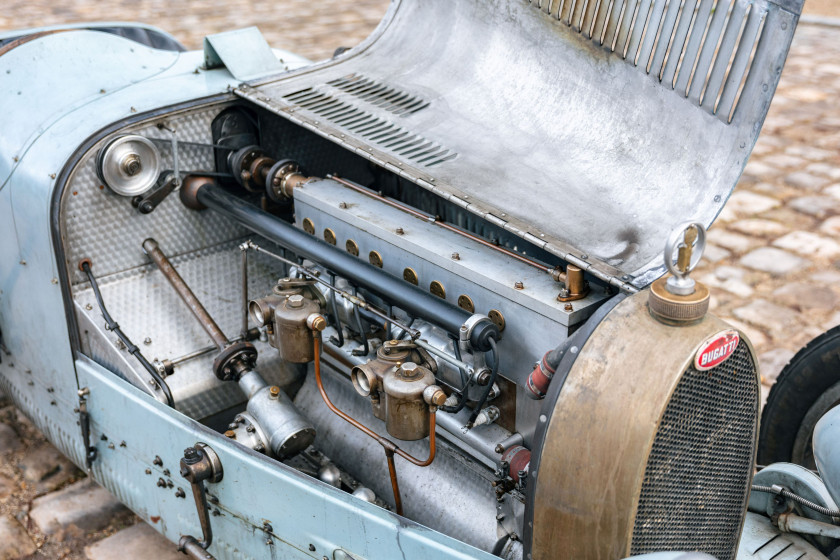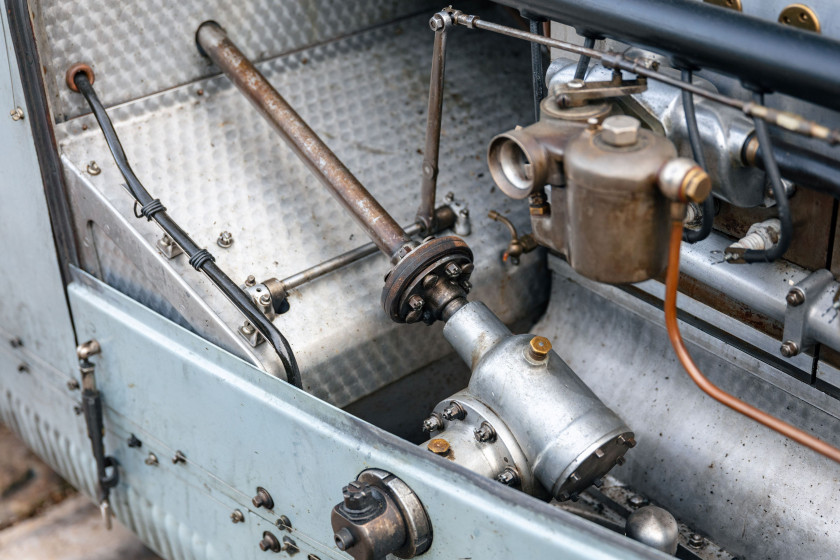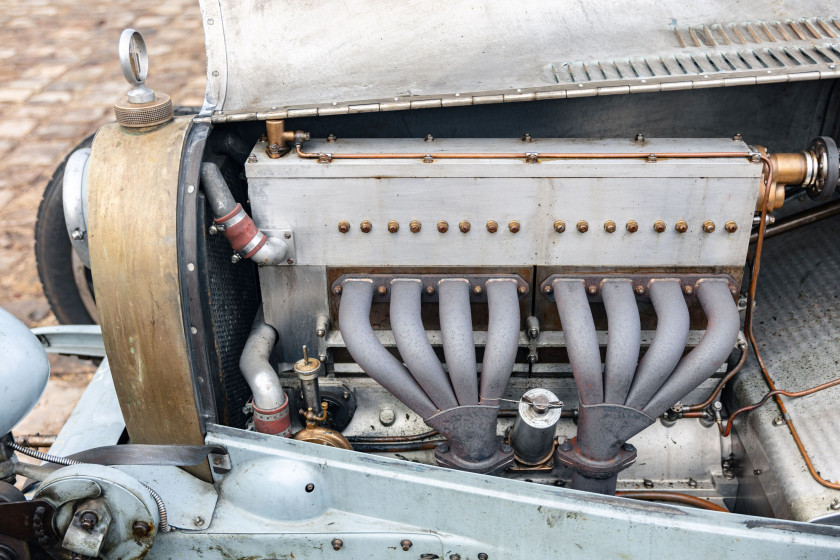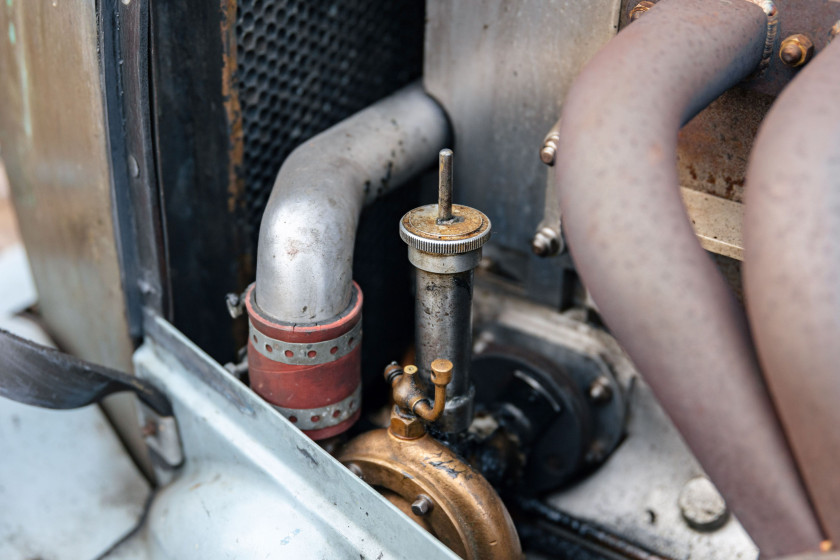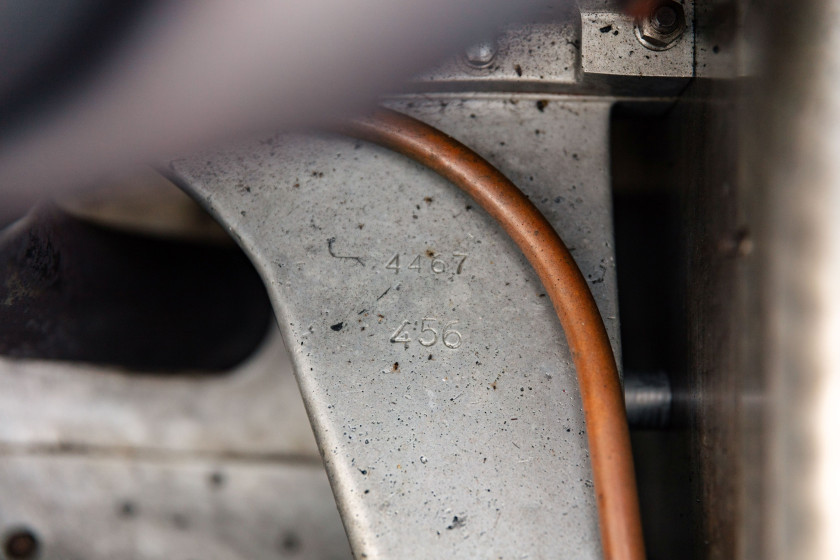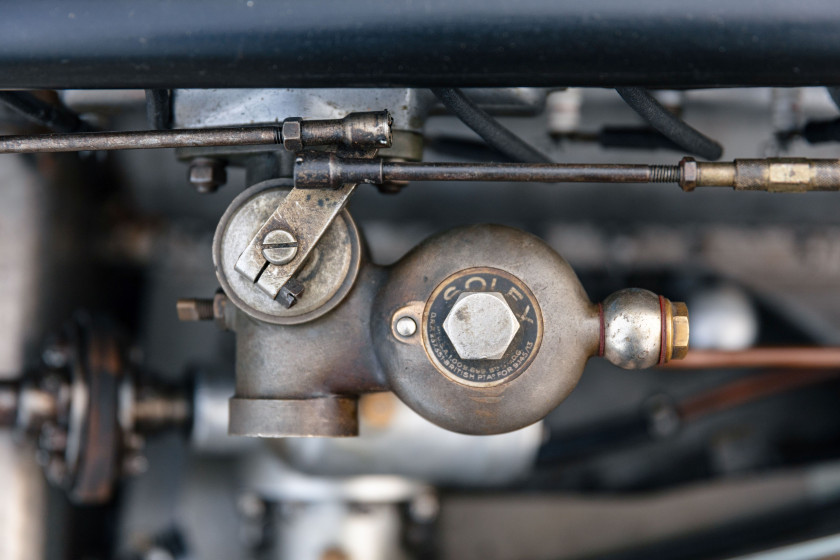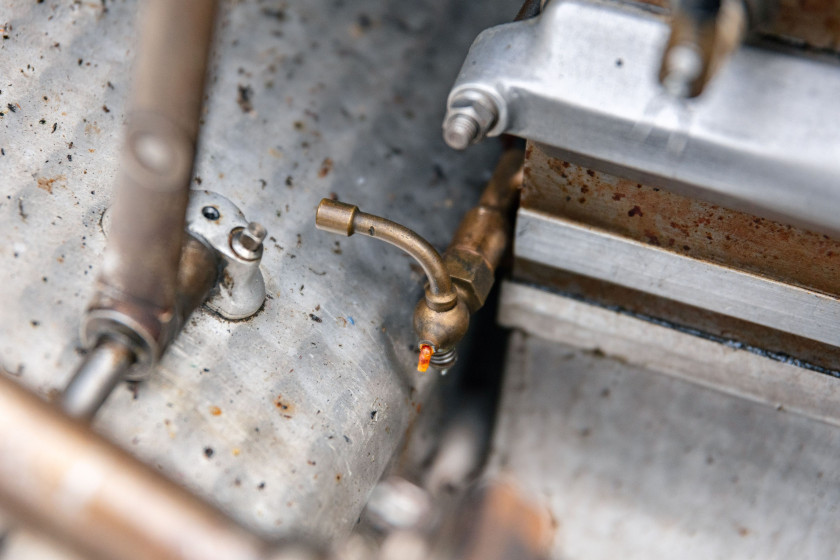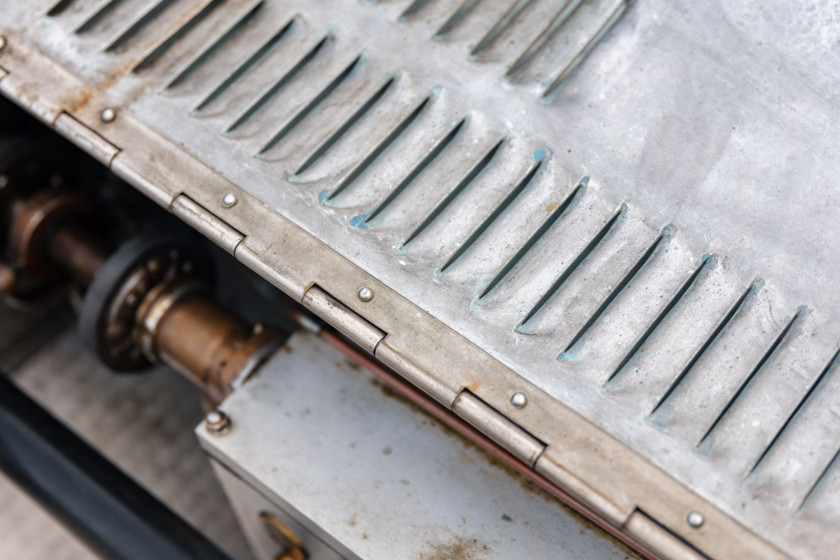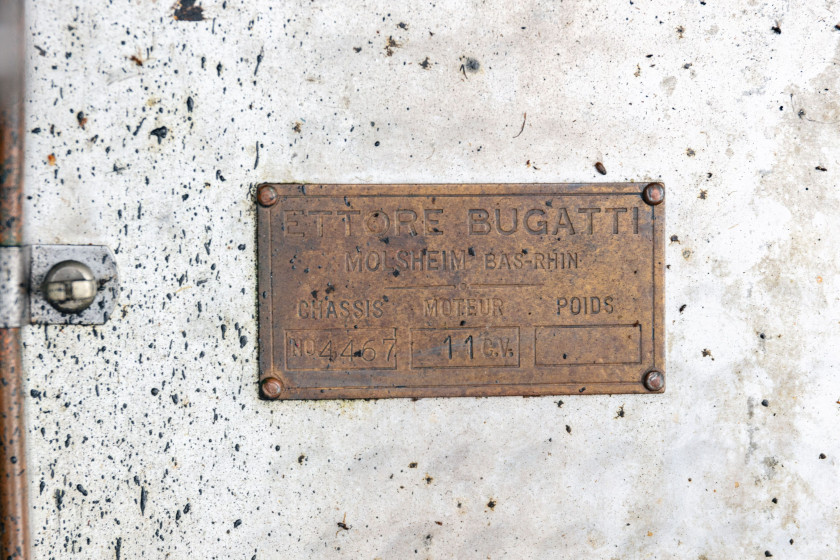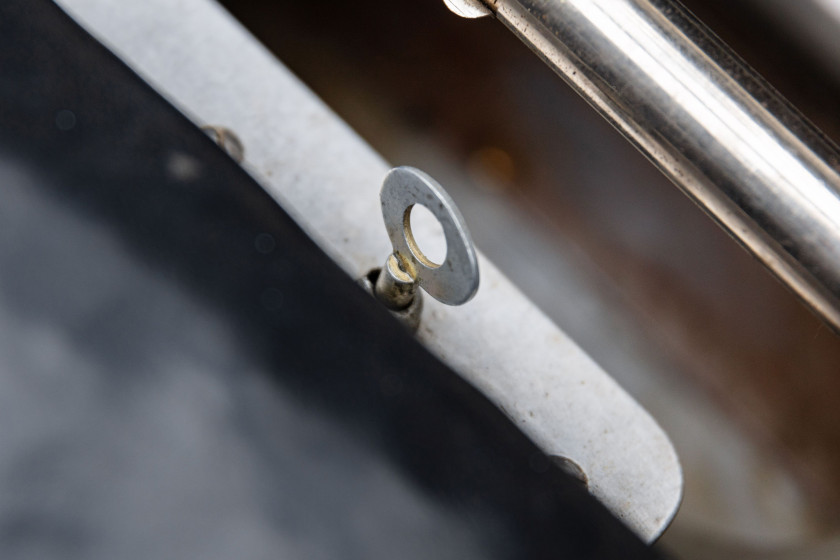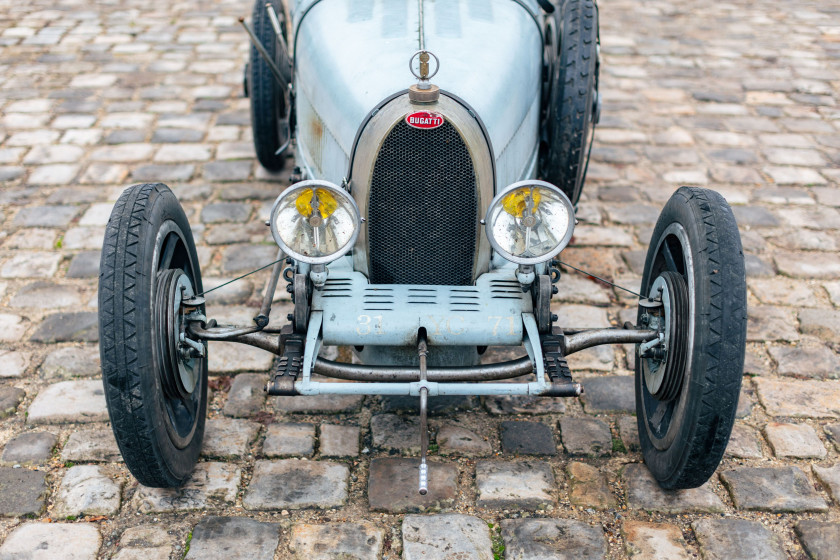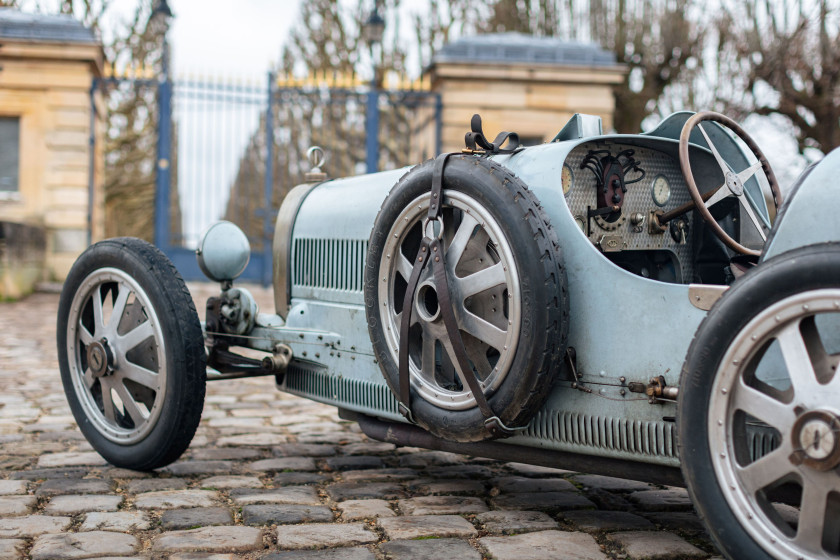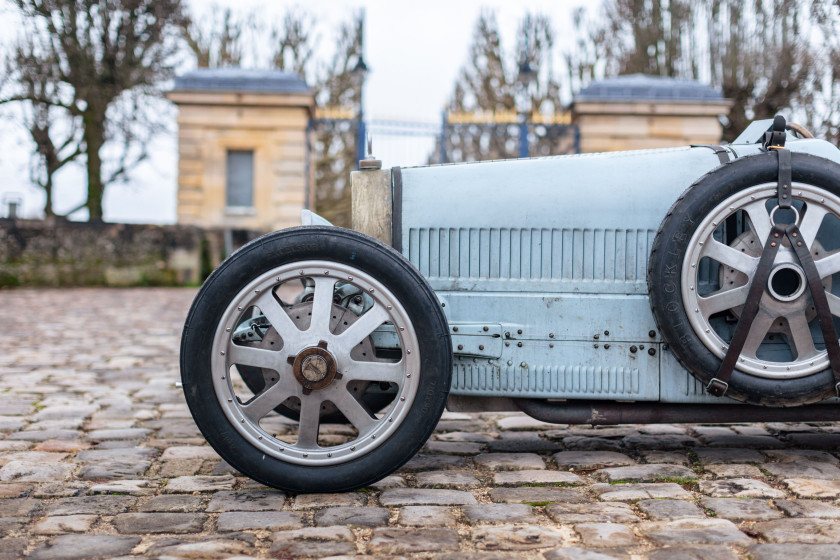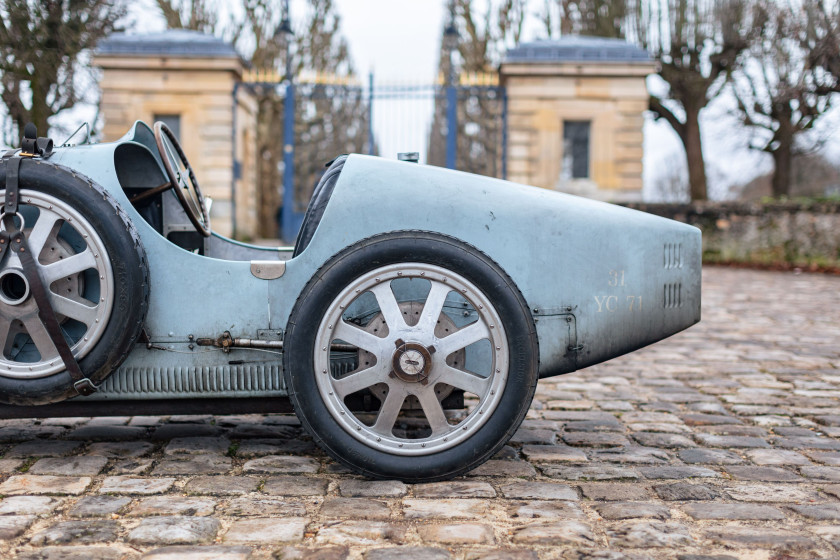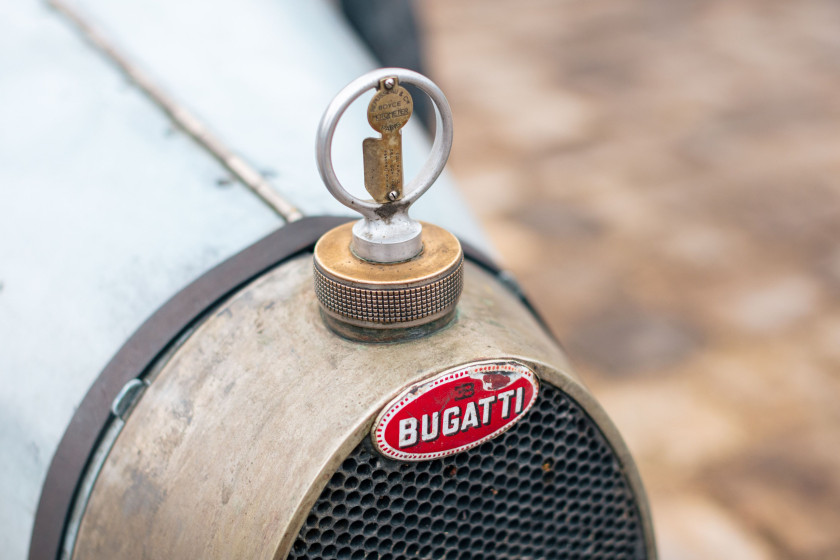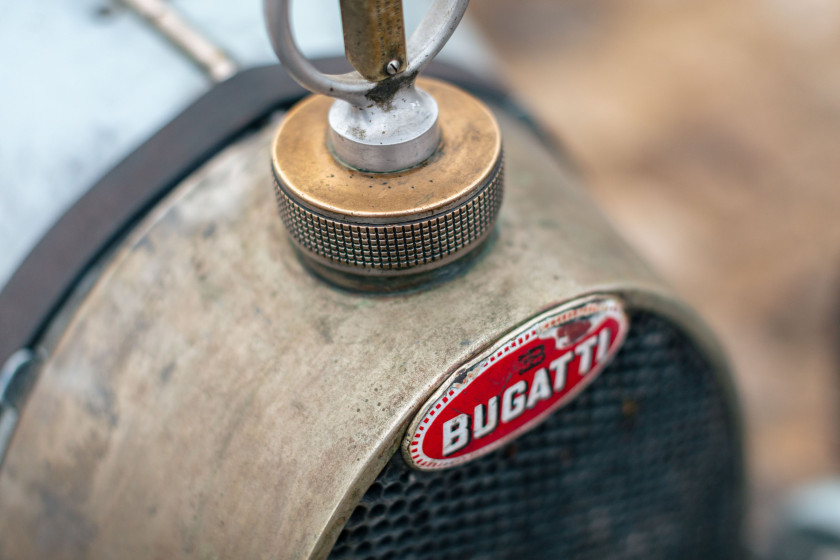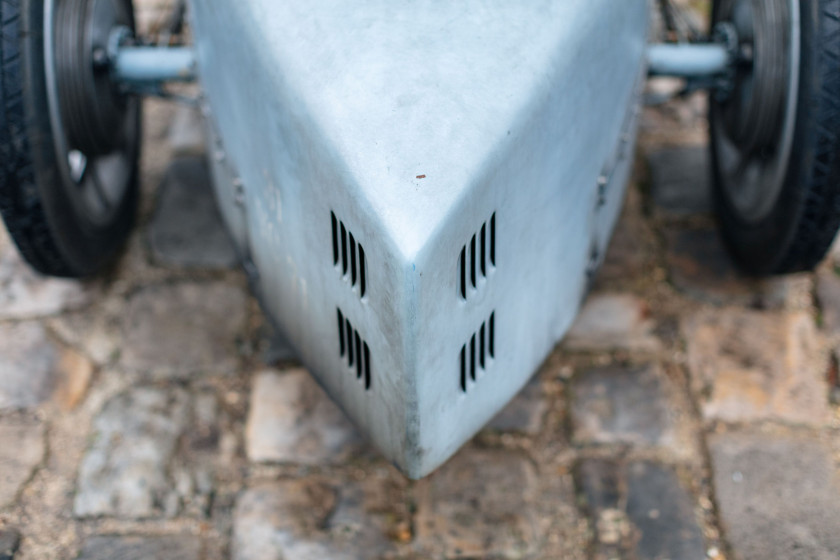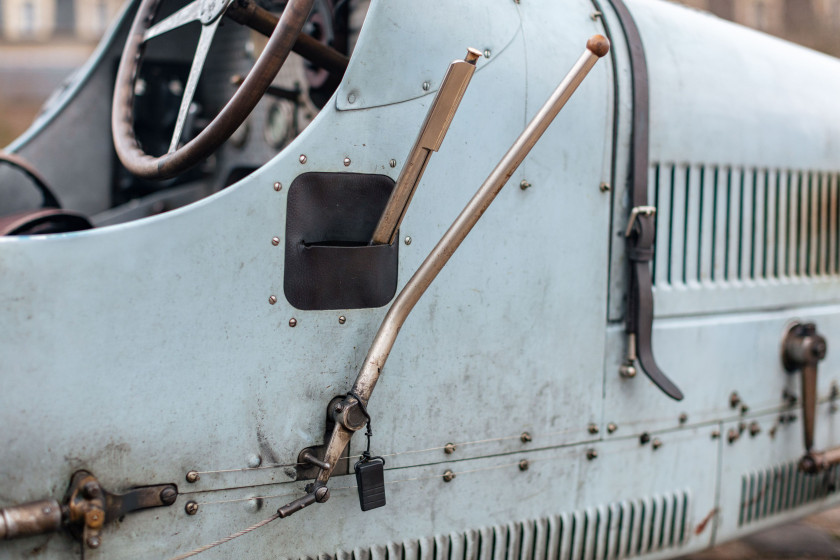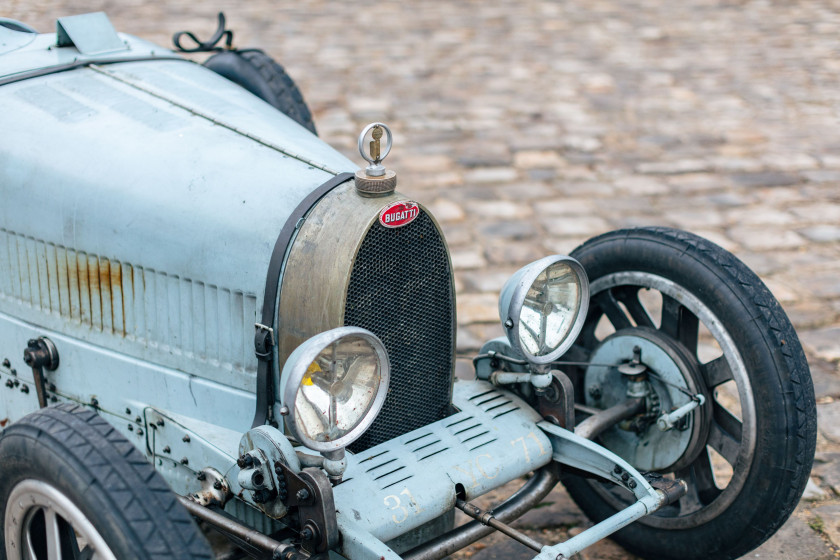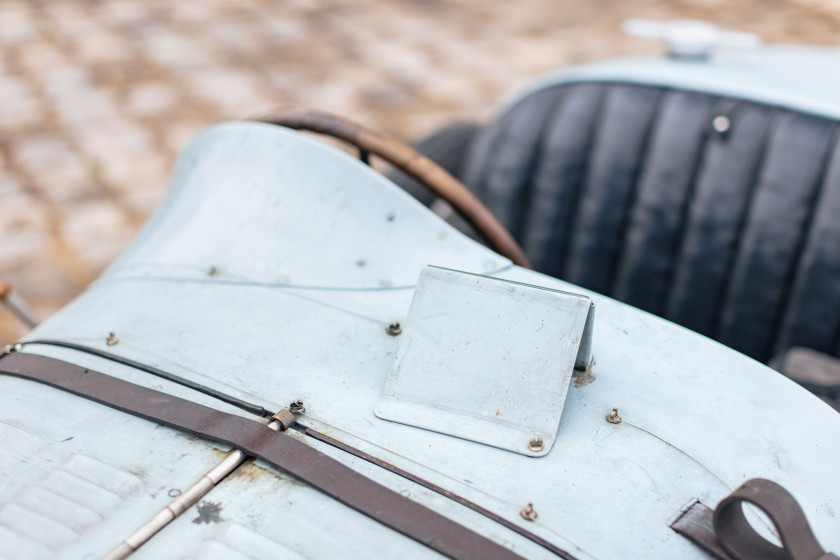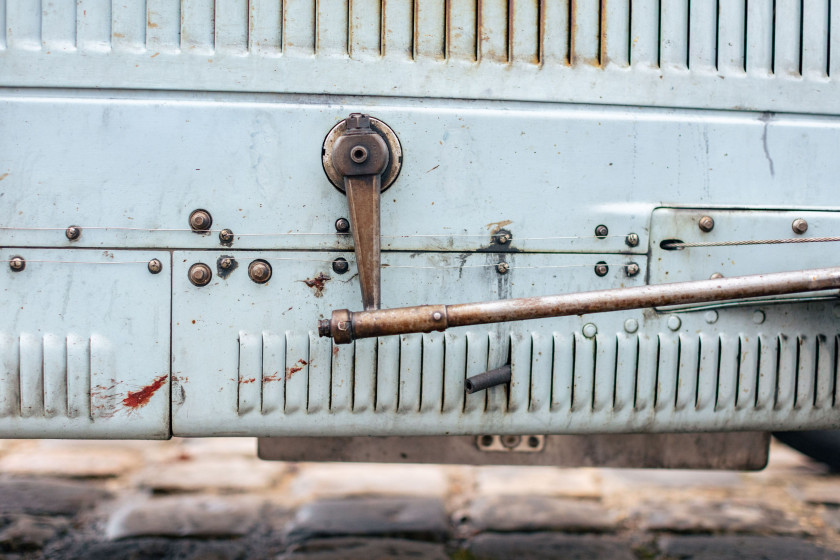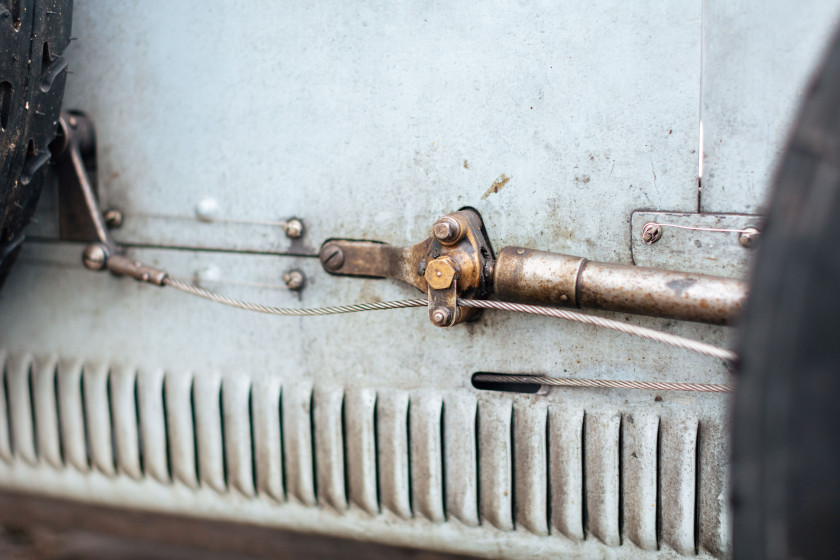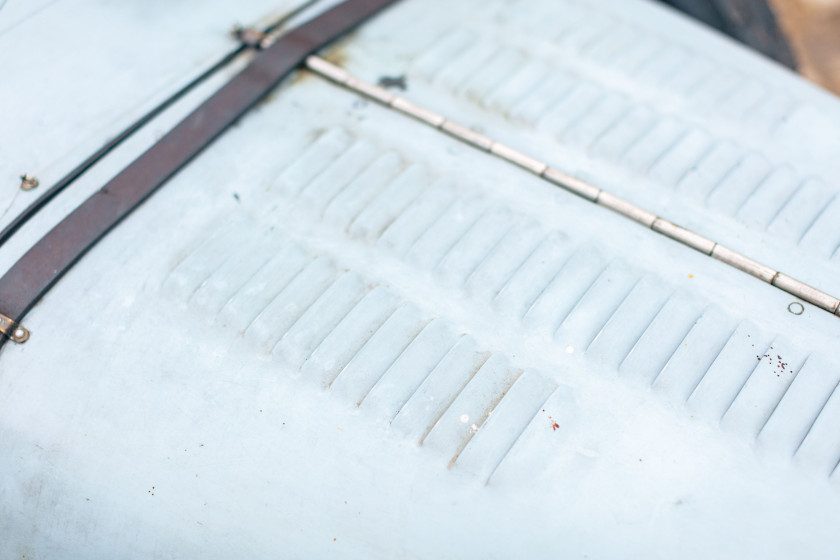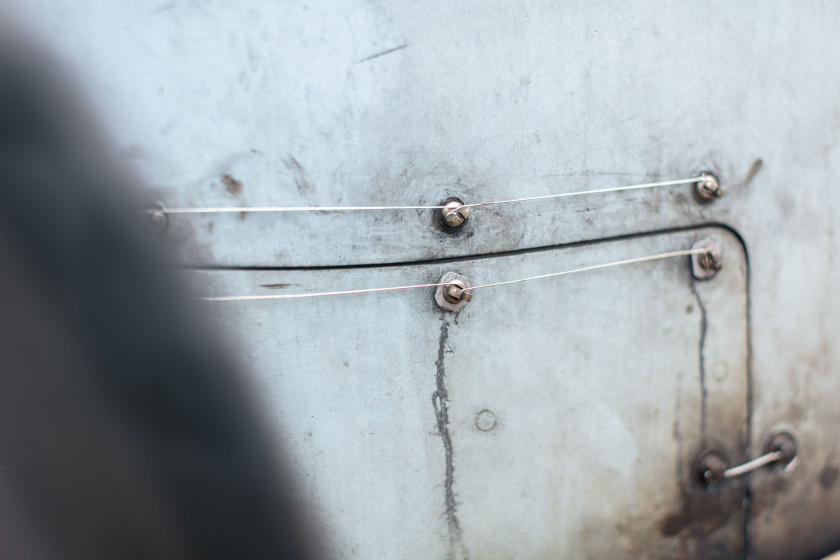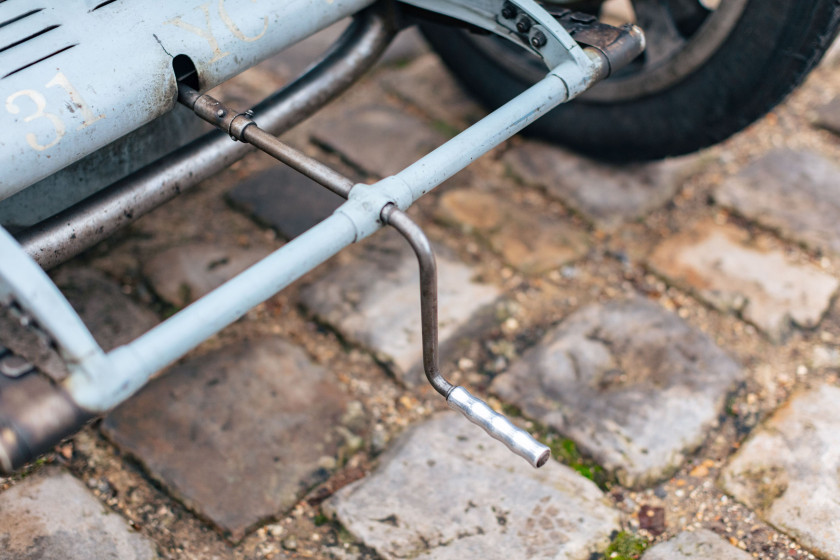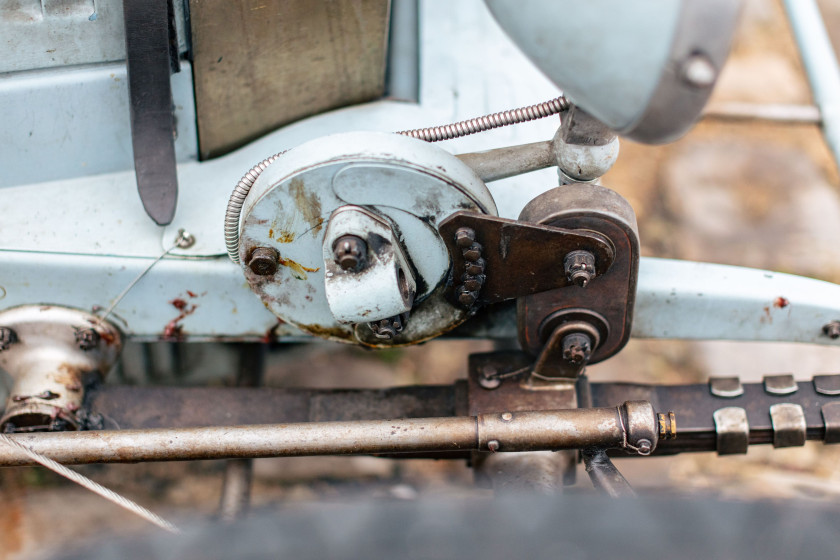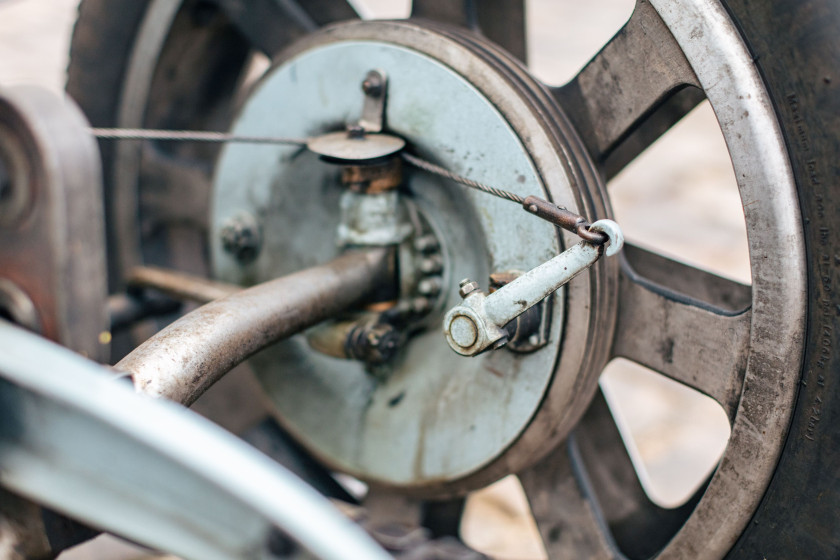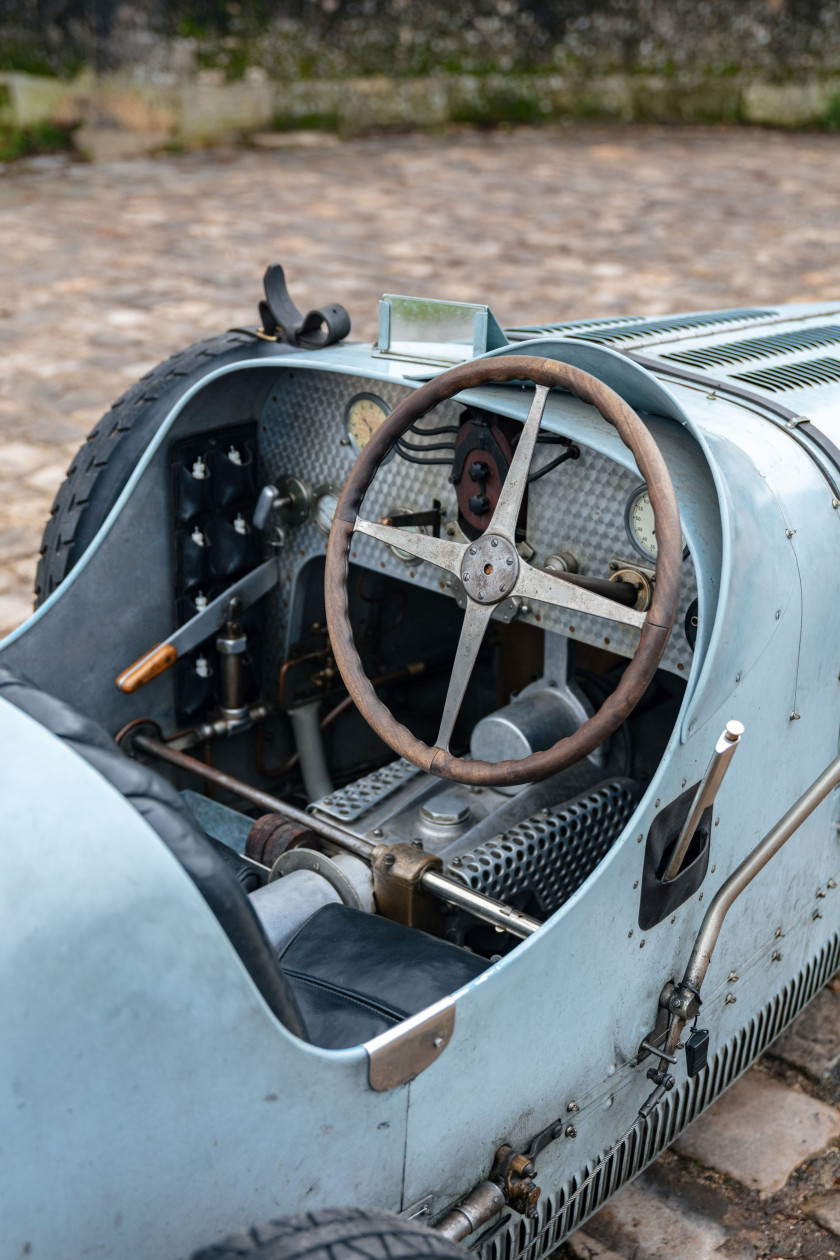Sale Rétromobile 2024 - 2-3 Feb. 2024 - 14:00 /Lot 12 1925 Bugatti Type 35 Grand Prix par Gilles Fournier No reserve
1925 Bugatti Type 35 Grand Prix par Gilles Fournier
No reserve
Carte grise française
Châssis n° 4467 (voir texte)
- Magnifique qualité d'exécution
- Nombreuses pièces d'origine
- Vendue au profit de l'association France Parkinson
- Sans réserve
" Palmarès du 24 janvier 1926 au 19 septembre 1926 - 503 victoires - Plus de 2 victoires par jour - 351 Premiers Prix - 47 Records " pouvait-on lire au cata-logue Bugatti en 1926 ! Ce palmarès édifiant, et qui devait nettement s'amplifier dans les années à venir, était en grande partie dû à ce que beaucoup considèrent comme LE chef d'œuvre d'Ettore Bugatti : le Type 35. Sa première appari-tion officielle a lieu le 3 août 1924 lors du Grand Prix de Lyon, et si les résultats ne sont pas au rendez-vous immédiatement, l'essentiel est là : un étroit radiateur en fer à cheval dans le prolongement duquel se dessine une carrosserie profilée et achevée par une pointe Bordino, de magnifiques jantes en aluminium coulé intégrant les tambours de freins, et un brillant 8 cylindres en ligne de 2L dérivé du Type 30. La qualité d'exécution de l'ensemble est remarquable, la voiture est équilibrée et rapide, elle ne tarde pas à s'imposer partout dans le monde. Au gré des réglementations, la 35 va évoluer voyant sa cylindrée augmenter (35T - 2300 cm3) et sa puissance s'accroître grâce au montage d'un compresseur (35 B et 35 C). Ces évolutions entraineront également quelques discrètes modifications esthétiques comme un radiateur élargi. Cela étant, la 35 " Grand Prix de Lyon " reste le premier jalon de cette histoire exceptionnelle et conserve une place à part dans le cœur des passionnés. Ce fut le cas de Gilles Fournier, expert reconnu de la marque Amilcar, auteur de plusieurs ouvrages de référence, que sa passion pour les automobiles de course d'avant-guerre et la marque Bugatti en particulier avait conduit à se mettre en quête de pièces de Bugatti dès le début des années 80, avec pour objectif de construire un type 35 le plus fidèle possible à l'origine. Au début des années 2000, il est rejoint par un ami, Emma-nuel Cognet qui souhaite également construire un modèle similaire. Les deux compères vont alors se consacrer à cet objectif avec une approche d'une ex-trême minutie. Ils entreprennent de nombreux voyages pour aller voir des voi-tures authentiques, réaliser un maximum de pièces avec d'anciens bleu de l'usine, tandis que ceux d'autre provenance sont systématiquement écartés. La construction du châssis et de la mécanique sont confiés à l'excellent Laurent Rondoni qui confectionne un moteur 2.3L alimenté par deux carburateurs Solex 40. Une fois le châssis roulant terminé, la carrosserie fut réalisée, en même temps que celle de sa sœur, chez Jean-Luc Bonnefoy, à Orval, où Gilles Four-nier retrouvait E. Cognet chaque mercredi pour travailler de concert sur les deux voitures. Plusieurs photos montrent le châssis en cours de montage. Les Bugatti jumelles furent achevées en 2005 et prirent immédiatement part à un rallye de plus de 1 500 km, sans encombre. L'historien Pierre-Yves Laugier nous a raconté être parti à la chasse d'une Bugatti à bord de cette 35, par un froid 1er novembre, en compagnie de son propriétaire. Après quelques aller-retours dans le village entre les murs duquel raisonnait le 8 cylindres, le propriétaire de la Bugatti recherchée fit irruption et accepta de leur montrer sa voiture. L'examen de la voiture de Gilles Fournier, 18 ans plus tard, montre la qualité du travail effectué, unanimement reconnu dans le milieu des Bugattistes, professionnels compris. La patine que présente la voiture, grâce aux nombreux kilomètres effectués, mais également par les pièces d'origine qui la composent, en font une réalisation exceptionnelle. Une liste des pièces originales d'époque avait été dres-sée par son propriétaire : radiateur (qui proviendrait de chez Germain Lambert) et son bouchon, essieu avant et fusées, boitier de direction, volant, pompe à eau, carburateurs, carter de boîte de vitesses portant le n° 157, carter de pont (autre provenance) 13x54 portant le n°105, système d'avance hélicoïdal, magné-to Bosch, instrumentation de tableau de bord, pompe à air à main, et diverses petites pièces. Du point de vue administratif, la voiture dispose d'une carte grise de collection de type 30A, châssis 4467, le type 30A servait à l'époque de désignation administrative pour les types 35 en 1924 / 1925.
C'est avec un plaisir non-dissimulé que nous nous sommes glissés derrière le volant de cette Bugatti, après avoir effectué les vérifications d'usage en compa-gnie de Frédéric Novo. A l'exception du démarreur qui devra être vérifié, abso-lument tout est fonctionnel, et la voiture s'avère très agréable à conduire. La puissance et la sonorité du 8 cylindres donnent envie de ne plus jamais s'arrêter, et de prendre la route vers le prochain Grand Prix.
Selon les dernières volontés de Gilles Fournier, ce chef d'œuvre sera vendu au profit de l'association France Parkinson.
France Parkinson est l'unique association nationale de soutien aux malades et aidants atteints par la maladie de Parkinson. France Parkinson est essentielle-ment financée par les dons et les legs et tient à exprimer sa profonde recon-naissance à la famille de Gilles Fournier, dont la générosité contribuera à l'accomplissement de nos missions sociales et de recherche.
French title
Chassis No 4467 (see text)
- Magnificent quality of execution
- Numerous original parts
- Sold for the benefit of the France Parkinson association
- No reserve
"Track record between the 24th January 1926 to the 19th September 1926 - 503 wins - Over 2 victories per day - 351 First Prizes - 47 Records" are the words written in the Bugatti catalogue in 1926! This enlightening list of achievements, which was expected to increase significantly in years to come, was largely due to what many considered to be THE masterpiece of Ettore Bugatti: the Type 35. Its first official appearance was on the 3rd August 1924 during the Lyon Grand Prix and even if the results were not instantly there, the essential part was there: a narrow horseshoe radiator in the extension of which you can find a profiled bodywork finished with a Bordino tip, gorgeous cast aluminium rims integrating the brake drums and a brilliant 8-cylinder in-line 2L engine derived from the Type 30. The overall quality of execution is simply incredible, the car is stable and fast and it didn't take long to establish itself worldwide.
The 35 evolved in accordance with regulations, seeing its cylinder capacity in-crease (35T-2,300 cc) and its power increase thanks to the fitting of a compres-sor (35 B and 35 C). These developments also led to some discreet aesthetic modifications such as a more enhanced radiator. That being said, the 35 "Grand Prix de Lyon" remains the first milestone in this exceptional history and still has a special place in the hearts of enthusiasts. It was also the case for Gilles Four-nier, renowned expert on the Amilcar brand, author of many reference publica-tions, whose passion for pre-war racing cars (and the Bugatti brand in particular) had led him to start looking for Bugatti 35 parts from the early 1980s, with the aim of building a Grand Prix as similar as possible to the original. In the early 2000s, he was joined by a friend, Emmanuel Cognet, who also wanted to build a 35.
Both friends will then commit themselves to this objective with an extremely me-ticulous approach. They carried out numerous trips to see authentic cars, pro-ducing as many parts as possible with the help of old factory blueprints, while those from other sources were systematically discarded.
The chassis and engine's build were entrusted to the excellent Laurent Rondini who made a 2.3L engine powered by two Solex 40 carburettors. Once the rolling chassis was completed, the bodywork was created at the same time of its sis-ter's one at Jean-Luc Bonnefoy in Orval, where Gilles Fournier met E. Cognet every Wednesday to work together on both cars. Numerous pictures show the chassis being assembled.
The twin Bugatti cars were completed in 2005 and instantly took part in a rally of more than 1,500 km, with no mishaps. The historian Pierre Yves Laugier told us that he went hunting for a Bugatti aboard this 35, on a cold November 1st along-side its owner. After a few back and forth to the village in-between walls where you could hear the 8-cylinder engine resonate, the owner of the Bugatti they were looking for appeared and accepted to show them his car.
18 years later, the inspection on Gilles Fournier's car demonstrates the quality of works carried out, unanimously recognised in the circle of Bugattists, profes-sionals included. Thanks to the amount of kilometres covered but also to original parts that were fitted, the patina on this particular car can only be described as an exceptional achievement. A list of original parts of that time had been drawn up by its owner: radiator (which came from Germain Lambert) and its cap, front axle and bearings, steering gear, steering wheel, water pump, carburettors, gearbox housing No 157, axle housing (other source) 13x54 No 105, helical feed system, Bosch magneto, instruments on the dashboard, hand air pump and vari-ous small parts. Administratively, the car has a type 30A collector's registration, chassis 4467. At the time, type 30A was used as the administrative designation for the type 35 in 1924 / 1925.
It was with undisguised pleasure that we went behind the wheel of this Bugatti, after carrying out our usual checks with Frederic Novo. With the exception of the starter which will need to be checked, absolutely everything is in working order and the car is very pleasant to drive. The power and sound of this 8-cylinder en-gine makes you want to keep going forever and take the road to the next Grand Prix.
Following the wishes of Gilles Fournier, this masterpiece will be sold for the benefit of the France Parkinson association.
France Parkinson is the only national association supporting patients and carers affected by Parkinson's disease. France Parkinson is primarily financed by do-nations and legacies and we would like to express our deep gratitude to Gilles Fournier's family, whose generosity will contribute to the achievements of our social and research missions.
Copyright Photos: Kevin Van Campenhout
Estimation 300 000 - 500 000 €
Sold 405,280 €
* Results are displayed including buyer’s fees and taxes. They are generated automatically and can be modified.
No reserve
Carte grise française
Châssis n° 4467 (voir texte)
- Magnifique qualité d'exécution
- Nombreuses pièces d'origine
- Vendue au profit de l'association France Parkinson
- Sans réserve
" Palmarès du 24 janvier 1926 au 19 septembre 1926 - 503 victoires - Plus de 2 victoires par jour - 351 Premiers Prix - 47 Records " pouvait-on lire au cata-logue Bugatti en 1926 ! Ce palmarès édifiant, et qui devait nettement s'amplifier dans les années à venir, était en grande partie dû à ce que beaucoup considèrent comme LE chef d'œuvre d'Ettore Bugatti : le Type 35. Sa première appari-tion officielle a lieu le 3 août 1924 lors du Grand Prix de Lyon, et si les résultats ne sont pas au rendez-vous immédiatement, l'essentiel est là : un étroit radiateur en fer à cheval dans le prolongement duquel se dessine une carrosserie profilée et achevée par une pointe Bordino, de magnifiques jantes en aluminium coulé intégrant les tambours de freins, et un brillant 8 cylindres en ligne de 2L dérivé du Type 30. La qualité d'exécution de l'ensemble est remarquable, la voiture est équilibrée et rapide, elle ne tarde pas à s'imposer partout dans le monde. Au gré des réglementations, la 35 va évoluer voyant sa cylindrée augmenter (35T - 2300 cm3) et sa puissance s'accroître grâce au montage d'un compresseur (35 B et 35 C). Ces évolutions entraineront également quelques discrètes modifications esthétiques comme un radiateur élargi. Cela étant, la 35 " Grand Prix de Lyon " reste le premier jalon de cette histoire exceptionnelle et conserve une place à part dans le cœur des passionnés. Ce fut le cas de Gilles Fournier, expert reconnu de la marque Amilcar, auteur de plusieurs ouvrages de référence, que sa passion pour les automobiles de course d'avant-guerre et la marque Bugatti en particulier avait conduit à se mettre en quête de pièces de Bugatti dès le début des années 80, avec pour objectif de construire un type 35 le plus fidèle possible à l'origine. Au début des années 2000, il est rejoint par un ami, Emma-nuel Cognet qui souhaite également construire un modèle similaire. Les deux compères vont alors se consacrer à cet objectif avec une approche d'une ex-trême minutie. Ils entreprennent de nombreux voyages pour aller voir des voi-tures authentiques, réaliser un maximum de pièces avec d'anciens bleu de l'usine, tandis que ceux d'autre provenance sont systématiquement écartés. La construction du châssis et de la mécanique sont confiés à l'excellent Laurent Rondoni qui confectionne un moteur 2.3L alimenté par deux carburateurs Solex 40. Une fois le châssis roulant terminé, la carrosserie fut réalisée, en même temps que celle de sa sœur, chez Jean-Luc Bonnefoy, à Orval, où Gilles Four-nier retrouvait E. Cognet chaque mercredi pour travailler de concert sur les deux voitures. Plusieurs photos montrent le châssis en cours de montage. Les Bugatti jumelles furent achevées en 2005 et prirent immédiatement part à un rallye de plus de 1 500 km, sans encombre. L'historien Pierre-Yves Laugier nous a raconté être parti à la chasse d'une Bugatti à bord de cette 35, par un froid 1er novembre, en compagnie de son propriétaire. Après quelques aller-retours dans le village entre les murs duquel raisonnait le 8 cylindres, le propriétaire de la Bugatti recherchée fit irruption et accepta de leur montrer sa voiture. L'examen de la voiture de Gilles Fournier, 18 ans plus tard, montre la qualité du travail effectué, unanimement reconnu dans le milieu des Bugattistes, professionnels compris. La patine que présente la voiture, grâce aux nombreux kilomètres effectués, mais également par les pièces d'origine qui la composent, en font une réalisation exceptionnelle. Une liste des pièces originales d'époque avait été dres-sée par son propriétaire : radiateur (qui proviendrait de chez Germain Lambert) et son bouchon, essieu avant et fusées, boitier de direction, volant, pompe à eau, carburateurs, carter de boîte de vitesses portant le n° 157, carter de pont (autre provenance) 13x54 portant le n°105, système d'avance hélicoïdal, magné-to Bosch, instrumentation de tableau de bord, pompe à air à main, et diverses petites pièces. Du point de vue administratif, la voiture dispose d'une carte grise de collection de type 30A, châssis 4467, le type 30A servait à l'époque de désignation administrative pour les types 35 en 1924 / 1925.
C'est avec un plaisir non-dissimulé que nous nous sommes glissés derrière le volant de cette Bugatti, après avoir effectué les vérifications d'usage en compa-gnie de Frédéric Novo. A l'exception du démarreur qui devra être vérifié, abso-lument tout est fonctionnel, et la voiture s'avère très agréable à conduire. La puissance et la sonorité du 8 cylindres donnent envie de ne plus jamais s'arrêter, et de prendre la route vers le prochain Grand Prix.
Selon les dernières volontés de Gilles Fournier, ce chef d'œuvre sera vendu au profit de l'association France Parkinson.
France Parkinson est l'unique association nationale de soutien aux malades et aidants atteints par la maladie de Parkinson. France Parkinson est essentielle-ment financée par les dons et les legs et tient à exprimer sa profonde recon-naissance à la famille de Gilles Fournier, dont la générosité contribuera à l'accomplissement de nos missions sociales et de recherche.
French title
Chassis No 4467 (see text)
- Magnificent quality of execution
- Numerous original parts
- Sold for the benefit of the France Parkinson association
- No reserve
"Track record between the 24th January 1926 to the 19th September 1926 - 503 wins - Over 2 victories per day - 351 First Prizes - 47 Records" are the words written in the Bugatti catalogue in 1926! This enlightening list of achievements, which was expected to increase significantly in years to come, was largely due to what many considered to be THE masterpiece of Ettore Bugatti: the Type 35. Its first official appearance was on the 3rd August 1924 during the Lyon Grand Prix and even if the results were not instantly there, the essential part was there: a narrow horseshoe radiator in the extension of which you can find a profiled bodywork finished with a Bordino tip, gorgeous cast aluminium rims integrating the brake drums and a brilliant 8-cylinder in-line 2L engine derived from the Type 30. The overall quality of execution is simply incredible, the car is stable and fast and it didn't take long to establish itself worldwide.
The 35 evolved in accordance with regulations, seeing its cylinder capacity in-crease (35T-2,300 cc) and its power increase thanks to the fitting of a compres-sor (35 B and 35 C). These developments also led to some discreet aesthetic modifications such as a more enhanced radiator. That being said, the 35 "Grand Prix de Lyon" remains the first milestone in this exceptional history and still has a special place in the hearts of enthusiasts. It was also the case for Gilles Four-nier, renowned expert on the Amilcar brand, author of many reference publica-tions, whose passion for pre-war racing cars (and the Bugatti brand in particular) had led him to start looking for Bugatti 35 parts from the early 1980s, with the aim of building a Grand Prix as similar as possible to the original. In the early 2000s, he was joined by a friend, Emmanuel Cognet, who also wanted to build a 35.
Both friends will then commit themselves to this objective with an extremely me-ticulous approach. They carried out numerous trips to see authentic cars, pro-ducing as many parts as possible with the help of old factory blueprints, while those from other sources were systematically discarded.
The chassis and engine's build were entrusted to the excellent Laurent Rondini who made a 2.3L engine powered by two Solex 40 carburettors. Once the rolling chassis was completed, the bodywork was created at the same time of its sis-ter's one at Jean-Luc Bonnefoy in Orval, where Gilles Fournier met E. Cognet every Wednesday to work together on both cars. Numerous pictures show the chassis being assembled.
The twin Bugatti cars were completed in 2005 and instantly took part in a rally of more than 1,500 km, with no mishaps. The historian Pierre Yves Laugier told us that he went hunting for a Bugatti aboard this 35, on a cold November 1st along-side its owner. After a few back and forth to the village in-between walls where you could hear the 8-cylinder engine resonate, the owner of the Bugatti they were looking for appeared and accepted to show them his car.
18 years later, the inspection on Gilles Fournier's car demonstrates the quality of works carried out, unanimously recognised in the circle of Bugattists, profes-sionals included. Thanks to the amount of kilometres covered but also to original parts that were fitted, the patina on this particular car can only be described as an exceptional achievement. A list of original parts of that time had been drawn up by its owner: radiator (which came from Germain Lambert) and its cap, front axle and bearings, steering gear, steering wheel, water pump, carburettors, gearbox housing No 157, axle housing (other source) 13x54 No 105, helical feed system, Bosch magneto, instruments on the dashboard, hand air pump and vari-ous small parts. Administratively, the car has a type 30A collector's registration, chassis 4467. At the time, type 30A was used as the administrative designation for the type 35 in 1924 / 1925.
It was with undisguised pleasure that we went behind the wheel of this Bugatti, after carrying out our usual checks with Frederic Novo. With the exception of the starter which will need to be checked, absolutely everything is in working order and the car is very pleasant to drive. The power and sound of this 8-cylinder en-gine makes you want to keep going forever and take the road to the next Grand Prix.
Following the wishes of Gilles Fournier, this masterpiece will be sold for the benefit of the France Parkinson association.
France Parkinson is the only national association supporting patients and carers affected by Parkinson's disease. France Parkinson is primarily financed by do-nations and legacies and we would like to express our deep gratitude to Gilles Fournier's family, whose generosity will contribute to the achievements of our social and research missions.
Copyright Photos: Kevin Van Campenhout
Estimation 300 000 - 500 000 €
Sold 405,280 €
* Results are displayed including buyer’s fees and taxes. They are generated automatically and can be modified.
Lot 12
1925 Bugatti Type 35 Grand Prix par Gilles Fournier
No reserve
Lot 12
No reserve
Sold 405,280 € [$]
1925 Bugatti Type 35 Grand Prix par Gilles Fournier
No reserve
Carte grise française
Châssis n° 4467 (voir texte)
- Magnifique qualité d'exécution
- Nombreuses pièces d'origine
- Vendue au profit de l'association France Parkinson
- Sans réserve
" Palmarès du 24 janvier 1926 au 19 septembre 1926 - 503 victoires - Plus de 2 victoires par jour - 351 Premiers Prix - 47 Records " pouvait-on lire au cata-logue Bugatti en 1926 ! Ce palmarès édifiant, et qui devait nettement s'amplifier dans les années à venir, était en grande partie dû à ce que beaucoup considèrent comme LE chef d'œuvre d'Ettore Bugatti : le Type 35. Sa première appari-tion officielle a lieu le 3 août 1924 lors du Grand Prix de Lyon, et si les résultats ne sont pas au rendez-vous immédiatement, l'essentiel est là : un étroit radiateur en fer à cheval dans le prolongement duquel se dessine une carrosserie profilée et achevée par une pointe Bordino, de magnifiques jantes en aluminium coulé intégrant les tambours de freins, et un brillant 8 cylindres en ligne de 2L dérivé du Type 30. La qualité d'exécution de l'ensemble est remarquable, la voiture est équilibrée et rapide, elle ne tarde pas à s'imposer partout dans le monde. Au gré des réglementations, la 35 va évoluer voyant sa cylindrée augmenter (35T - 2300 cm3) et sa puissance s'accroître grâce au montage d'un compresseur (35 B et 35 C). Ces évolutions entraineront également quelques discrètes modifications esthétiques comme un radiateur élargi. Cela étant, la 35 " Grand Prix de Lyon " reste le premier jalon de cette histoire exceptionnelle et conserve une place à part dans le cœur des passionnés. Ce fut le cas de Gilles Fournier, expert reconnu de la marque Amilcar, auteur de plusieurs ouvrages de référence, que sa passion pour les automobiles de course d'avant-guerre et la marque Bugatti en particulier avait conduit à se mettre en quête de pièces de Bugatti dès le début des années 80, avec pour objectif de construire un type 35 le plus fidèle possible à l'origine. Au début des années 2000, il est rejoint par un ami, Emma-nuel Cognet qui souhaite également construire un modèle similaire. Les deux compères vont alors se consacrer à cet objectif avec une approche d'une ex-trême minutie. Ils entreprennent de nombreux voyages pour aller voir des voi-tures authentiques, réaliser un maximum de pièces avec d'anciens bleu de l'usine, tandis que ceux d'autre provenance sont systématiquement écartés. La construction du châssis et de la mécanique sont confiés à l'excellent Laurent Rondoni qui confectionne un moteur 2.3L alimenté par deux carburateurs Solex 40. Une fois le châssis roulant terminé, la carrosserie fut réalisée, en même temps que celle de sa sœur, chez Jean-Luc Bonnefoy, à Orval, où Gilles Four-nier retrouvait E. Cognet chaque mercredi pour travailler de concert sur les deux voitures. Plusieurs photos montrent le châssis en cours de montage. Les Bugatti jumelles furent achevées en 2005 et prirent immédiatement part à un rallye de plus de 1 500 km, sans encombre. L'historien Pierre-Yves Laugier nous a raconté être parti à la chasse d'une Bugatti à bord de cette 35, par un froid 1er novembre, en compagnie de son propriétaire. Après quelques aller-retours dans le village entre les murs duquel raisonnait le 8 cylindres, le propriétaire de la Bugatti recherchée fit irruption et accepta de leur montrer sa voiture. L'examen de la voiture de Gilles Fournier, 18 ans plus tard, montre la qualité du travail effectué, unanimement reconnu dans le milieu des Bugattistes, professionnels compris. La patine que présente la voiture, grâce aux nombreux kilomètres effectués, mais également par les pièces d'origine qui la composent, en font une réalisation exceptionnelle. Une liste des pièces originales d'époque avait été dres-sée par son propriétaire : radiateur (qui proviendrait de chez Germain Lambert) et son bouchon, essieu avant et fusées, boitier de direction, volant, pompe à eau, carburateurs, carter de boîte de vitesses portant le n° 157, carter de pont (autre provenance) 13x54 portant le n°105, système d'avance hélicoïdal, magné-to Bosch, instrumentation de tableau de bord, pompe à air à main, et diverses petites pièces. Du point de vue administratif, la voiture dispose d'une carte grise de collection de type 30A, châssis 4467, le type 30A servait à l'époque de désignation administrative pour les types 35 en 1924 / 1925.
C'est avec un plaisir non-dissimulé que nous nous sommes glissés derrière le volant de cette Bugatti, après avoir effectué les vérifications d'usage en compa-gnie de Frédéric Novo. A l'exception du démarreur qui devra être vérifié, abso-lument tout est fonctionnel, et la voiture s'avère très agréable à conduire. La puissance et la sonorité du 8 cylindres donnent envie de ne plus jamais s'arrêter, et de prendre la route vers le prochain Grand Prix.
Selon les dernières volontés de Gilles Fournier, ce chef d'œuvre sera vendu au profit de l'association France Parkinson.
France Parkinson est l'unique association nationale de soutien aux malades et aidants atteints par la maladie de Parkinson. France Parkinson est essentielle-ment financée par les dons et les legs et tient à exprimer sa profonde recon-naissance à la famille de Gilles Fournier, dont la générosité contribuera à l'accomplissement de nos missions sociales et de recherche.
French title
Chassis No 4467 (see text)
- Magnificent quality of execution
- Numerous original parts
- Sold for the benefit of the France Parkinson association
- No reserve
"Track record between the 24th January 1926 to the 19th September 1926 - 503 wins - Over 2 victories per day - 351 First Prizes - 47 Records" are the words written in the Bugatti catalogue in 1926! This enlightening list of achievements, which was expected to increase significantly in years to come, was largely due to what many considered to be THE masterpiece of Ettore Bugatti: the Type 35. Its first official appearance was on the 3rd August 1924 during the Lyon Grand Prix and even if the results were not instantly there, the essential part was there: a narrow horseshoe radiator in the extension of which you can find a profiled bodywork finished with a Bordino tip, gorgeous cast aluminium rims integrating the brake drums and a brilliant 8-cylinder in-line 2L engine derived from the Type 30. The overall quality of execution is simply incredible, the car is stable and fast and it didn't take long to establish itself worldwide.
The 35 evolved in accordance with regulations, seeing its cylinder capacity in-crease (35T-2,300 cc) and its power increase thanks to the fitting of a compres-sor (35 B and 35 C). These developments also led to some discreet aesthetic modifications such as a more enhanced radiator. That being said, the 35 "Grand Prix de Lyon" remains the first milestone in this exceptional history and still has a special place in the hearts of enthusiasts. It was also the case for Gilles Four-nier, renowned expert on the Amilcar brand, author of many reference publica-tions, whose passion for pre-war racing cars (and the Bugatti brand in particular) had led him to start looking for Bugatti 35 parts from the early 1980s, with the aim of building a Grand Prix as similar as possible to the original. In the early 2000s, he was joined by a friend, Emmanuel Cognet, who also wanted to build a 35.
Both friends will then commit themselves to this objective with an extremely me-ticulous approach. They carried out numerous trips to see authentic cars, pro-ducing as many parts as possible with the help of old factory blueprints, while those from other sources were systematically discarded.
The chassis and engine's build were entrusted to the excellent Laurent Rondini who made a 2.3L engine powered by two Solex 40 carburettors. Once the rolling chassis was completed, the bodywork was created at the same time of its sis-ter's one at Jean-Luc Bonnefoy in Orval, where Gilles Fournier met E. Cognet every Wednesday to work together on both cars. Numerous pictures show the chassis being assembled.
The twin Bugatti cars were completed in 2005 and instantly took part in a rally of more than 1,500 km, with no mishaps. The historian Pierre Yves Laugier told us that he went hunting for a Bugatti aboard this 35, on a cold November 1st along-side its owner. After a few back and forth to the village in-between walls where you could hear the 8-cylinder engine resonate, the owner of the Bugatti they were looking for appeared and accepted to show them his car.
18 years later, the inspection on Gilles Fournier's car demonstrates the quality of works carried out, unanimously recognised in the circle of Bugattists, profes-sionals included. Thanks to the amount of kilometres covered but also to original parts that were fitted, the patina on this particular car can only be described as an exceptional achievement. A list of original parts of that time had been drawn up by its owner: radiator (which came from Germain Lambert) and its cap, front axle and bearings, steering gear, steering wheel, water pump, carburettors, gearbox housing No 157, axle housing (other source) 13x54 No 105, helical feed system, Bosch magneto, instruments on the dashboard, hand air pump and vari-ous small parts. Administratively, the car has a type 30A collector's registration, chassis 4467. At the time, type 30A was used as the administrative designation for the type 35 in 1924 / 1925.
It was with undisguised pleasure that we went behind the wheel of this Bugatti, after carrying out our usual checks with Frederic Novo. With the exception of the starter which will need to be checked, absolutely everything is in working order and the car is very pleasant to drive. The power and sound of this 8-cylinder en-gine makes you want to keep going forever and take the road to the next Grand Prix.
Following the wishes of Gilles Fournier, this masterpiece will be sold for the benefit of the France Parkinson association.
France Parkinson is the only national association supporting patients and carers affected by Parkinson's disease. France Parkinson is primarily financed by do-nations and legacies and we would like to express our deep gratitude to Gilles Fournier's family, whose generosity will contribute to the achievements of our social and research missions.
Copyright Photos: Kevin Van Campenhout
Estimation 300 000 - 500 000 €
Sold 405,280 €
* Results are displayed including buyer’s fees and taxes. They are generated automatically and can be modified.
No reserve
Carte grise française
Châssis n° 4467 (voir texte)
- Magnifique qualité d'exécution
- Nombreuses pièces d'origine
- Vendue au profit de l'association France Parkinson
- Sans réserve
" Palmarès du 24 janvier 1926 au 19 septembre 1926 - 503 victoires - Plus de 2 victoires par jour - 351 Premiers Prix - 47 Records " pouvait-on lire au cata-logue Bugatti en 1926 ! Ce palmarès édifiant, et qui devait nettement s'amplifier dans les années à venir, était en grande partie dû à ce que beaucoup considèrent comme LE chef d'œuvre d'Ettore Bugatti : le Type 35. Sa première appari-tion officielle a lieu le 3 août 1924 lors du Grand Prix de Lyon, et si les résultats ne sont pas au rendez-vous immédiatement, l'essentiel est là : un étroit radiateur en fer à cheval dans le prolongement duquel se dessine une carrosserie profilée et achevée par une pointe Bordino, de magnifiques jantes en aluminium coulé intégrant les tambours de freins, et un brillant 8 cylindres en ligne de 2L dérivé du Type 30. La qualité d'exécution de l'ensemble est remarquable, la voiture est équilibrée et rapide, elle ne tarde pas à s'imposer partout dans le monde. Au gré des réglementations, la 35 va évoluer voyant sa cylindrée augmenter (35T - 2300 cm3) et sa puissance s'accroître grâce au montage d'un compresseur (35 B et 35 C). Ces évolutions entraineront également quelques discrètes modifications esthétiques comme un radiateur élargi. Cela étant, la 35 " Grand Prix de Lyon " reste le premier jalon de cette histoire exceptionnelle et conserve une place à part dans le cœur des passionnés. Ce fut le cas de Gilles Fournier, expert reconnu de la marque Amilcar, auteur de plusieurs ouvrages de référence, que sa passion pour les automobiles de course d'avant-guerre et la marque Bugatti en particulier avait conduit à se mettre en quête de pièces de Bugatti dès le début des années 80, avec pour objectif de construire un type 35 le plus fidèle possible à l'origine. Au début des années 2000, il est rejoint par un ami, Emma-nuel Cognet qui souhaite également construire un modèle similaire. Les deux compères vont alors se consacrer à cet objectif avec une approche d'une ex-trême minutie. Ils entreprennent de nombreux voyages pour aller voir des voi-tures authentiques, réaliser un maximum de pièces avec d'anciens bleu de l'usine, tandis que ceux d'autre provenance sont systématiquement écartés. La construction du châssis et de la mécanique sont confiés à l'excellent Laurent Rondoni qui confectionne un moteur 2.3L alimenté par deux carburateurs Solex 40. Une fois le châssis roulant terminé, la carrosserie fut réalisée, en même temps que celle de sa sœur, chez Jean-Luc Bonnefoy, à Orval, où Gilles Four-nier retrouvait E. Cognet chaque mercredi pour travailler de concert sur les deux voitures. Plusieurs photos montrent le châssis en cours de montage. Les Bugatti jumelles furent achevées en 2005 et prirent immédiatement part à un rallye de plus de 1 500 km, sans encombre. L'historien Pierre-Yves Laugier nous a raconté être parti à la chasse d'une Bugatti à bord de cette 35, par un froid 1er novembre, en compagnie de son propriétaire. Après quelques aller-retours dans le village entre les murs duquel raisonnait le 8 cylindres, le propriétaire de la Bugatti recherchée fit irruption et accepta de leur montrer sa voiture. L'examen de la voiture de Gilles Fournier, 18 ans plus tard, montre la qualité du travail effectué, unanimement reconnu dans le milieu des Bugattistes, professionnels compris. La patine que présente la voiture, grâce aux nombreux kilomètres effectués, mais également par les pièces d'origine qui la composent, en font une réalisation exceptionnelle. Une liste des pièces originales d'époque avait été dres-sée par son propriétaire : radiateur (qui proviendrait de chez Germain Lambert) et son bouchon, essieu avant et fusées, boitier de direction, volant, pompe à eau, carburateurs, carter de boîte de vitesses portant le n° 157, carter de pont (autre provenance) 13x54 portant le n°105, système d'avance hélicoïdal, magné-to Bosch, instrumentation de tableau de bord, pompe à air à main, et diverses petites pièces. Du point de vue administratif, la voiture dispose d'une carte grise de collection de type 30A, châssis 4467, le type 30A servait à l'époque de désignation administrative pour les types 35 en 1924 / 1925.
C'est avec un plaisir non-dissimulé que nous nous sommes glissés derrière le volant de cette Bugatti, après avoir effectué les vérifications d'usage en compa-gnie de Frédéric Novo. A l'exception du démarreur qui devra être vérifié, abso-lument tout est fonctionnel, et la voiture s'avère très agréable à conduire. La puissance et la sonorité du 8 cylindres donnent envie de ne plus jamais s'arrêter, et de prendre la route vers le prochain Grand Prix.
Selon les dernières volontés de Gilles Fournier, ce chef d'œuvre sera vendu au profit de l'association France Parkinson.
France Parkinson est l'unique association nationale de soutien aux malades et aidants atteints par la maladie de Parkinson. France Parkinson est essentielle-ment financée par les dons et les legs et tient à exprimer sa profonde recon-naissance à la famille de Gilles Fournier, dont la générosité contribuera à l'accomplissement de nos missions sociales et de recherche.
French title
Chassis No 4467 (see text)
- Magnificent quality of execution
- Numerous original parts
- Sold for the benefit of the France Parkinson association
- No reserve
"Track record between the 24th January 1926 to the 19th September 1926 - 503 wins - Over 2 victories per day - 351 First Prizes - 47 Records" are the words written in the Bugatti catalogue in 1926! This enlightening list of achievements, which was expected to increase significantly in years to come, was largely due to what many considered to be THE masterpiece of Ettore Bugatti: the Type 35. Its first official appearance was on the 3rd August 1924 during the Lyon Grand Prix and even if the results were not instantly there, the essential part was there: a narrow horseshoe radiator in the extension of which you can find a profiled bodywork finished with a Bordino tip, gorgeous cast aluminium rims integrating the brake drums and a brilliant 8-cylinder in-line 2L engine derived from the Type 30. The overall quality of execution is simply incredible, the car is stable and fast and it didn't take long to establish itself worldwide.
The 35 evolved in accordance with regulations, seeing its cylinder capacity in-crease (35T-2,300 cc) and its power increase thanks to the fitting of a compres-sor (35 B and 35 C). These developments also led to some discreet aesthetic modifications such as a more enhanced radiator. That being said, the 35 "Grand Prix de Lyon" remains the first milestone in this exceptional history and still has a special place in the hearts of enthusiasts. It was also the case for Gilles Four-nier, renowned expert on the Amilcar brand, author of many reference publica-tions, whose passion for pre-war racing cars (and the Bugatti brand in particular) had led him to start looking for Bugatti 35 parts from the early 1980s, with the aim of building a Grand Prix as similar as possible to the original. In the early 2000s, he was joined by a friend, Emmanuel Cognet, who also wanted to build a 35.
Both friends will then commit themselves to this objective with an extremely me-ticulous approach. They carried out numerous trips to see authentic cars, pro-ducing as many parts as possible with the help of old factory blueprints, while those from other sources were systematically discarded.
The chassis and engine's build were entrusted to the excellent Laurent Rondini who made a 2.3L engine powered by two Solex 40 carburettors. Once the rolling chassis was completed, the bodywork was created at the same time of its sis-ter's one at Jean-Luc Bonnefoy in Orval, where Gilles Fournier met E. Cognet every Wednesday to work together on both cars. Numerous pictures show the chassis being assembled.
The twin Bugatti cars were completed in 2005 and instantly took part in a rally of more than 1,500 km, with no mishaps. The historian Pierre Yves Laugier told us that he went hunting for a Bugatti aboard this 35, on a cold November 1st along-side its owner. After a few back and forth to the village in-between walls where you could hear the 8-cylinder engine resonate, the owner of the Bugatti they were looking for appeared and accepted to show them his car.
18 years later, the inspection on Gilles Fournier's car demonstrates the quality of works carried out, unanimously recognised in the circle of Bugattists, profes-sionals included. Thanks to the amount of kilometres covered but also to original parts that were fitted, the patina on this particular car can only be described as an exceptional achievement. A list of original parts of that time had been drawn up by its owner: radiator (which came from Germain Lambert) and its cap, front axle and bearings, steering gear, steering wheel, water pump, carburettors, gearbox housing No 157, axle housing (other source) 13x54 No 105, helical feed system, Bosch magneto, instruments on the dashboard, hand air pump and vari-ous small parts. Administratively, the car has a type 30A collector's registration, chassis 4467. At the time, type 30A was used as the administrative designation for the type 35 in 1924 / 1925.
It was with undisguised pleasure that we went behind the wheel of this Bugatti, after carrying out our usual checks with Frederic Novo. With the exception of the starter which will need to be checked, absolutely everything is in working order and the car is very pleasant to drive. The power and sound of this 8-cylinder en-gine makes you want to keep going forever and take the road to the next Grand Prix.
Following the wishes of Gilles Fournier, this masterpiece will be sold for the benefit of the France Parkinson association.
France Parkinson is the only national association supporting patients and carers affected by Parkinson's disease. France Parkinson is primarily financed by do-nations and legacies and we would like to express our deep gratitude to Gilles Fournier's family, whose generosity will contribute to the achievements of our social and research missions.
Copyright Photos: Kevin Van Campenhout
Estimation 300 000 - 500 000 €
Sold 405,280 €
* Results are displayed including buyer’s fees and taxes. They are generated automatically and can be modified.
Sale’s details
Sale: 4404
Location: Salon Rétromobile, Paris
Date: 02 Feb. 2024 14:00
Auctioneer: Hervé Poulain
Location: Salon Rétromobile, Paris
Date: 02 Feb. 2024 14:00
Auctioneer: Hervé Poulain
Contact
Absentee Bids
& Telephone Bids
Kristina Vrzests
Phone +33 1 42 99 20 51
bids@artcurial.com
Conditions of Purchase

